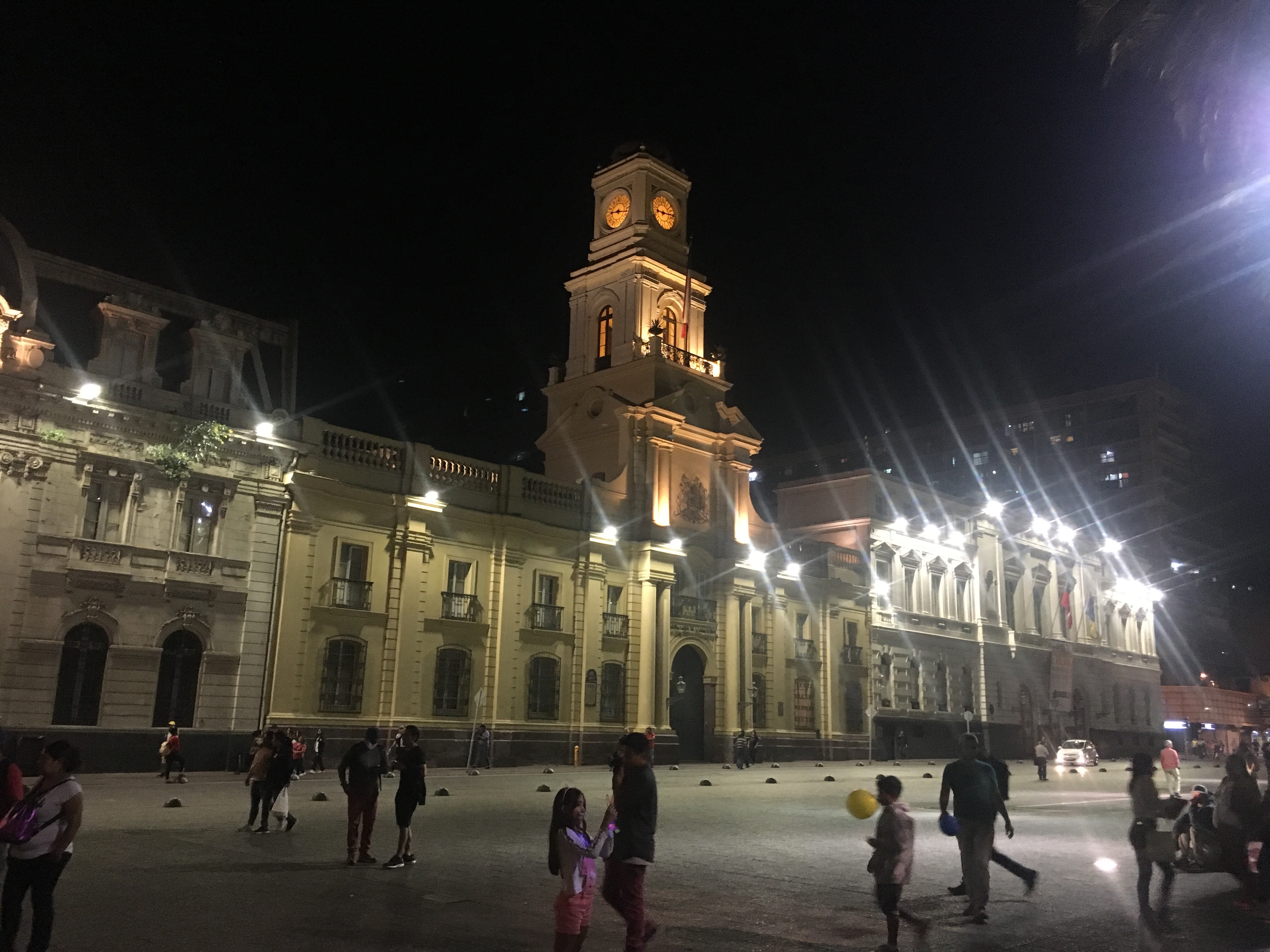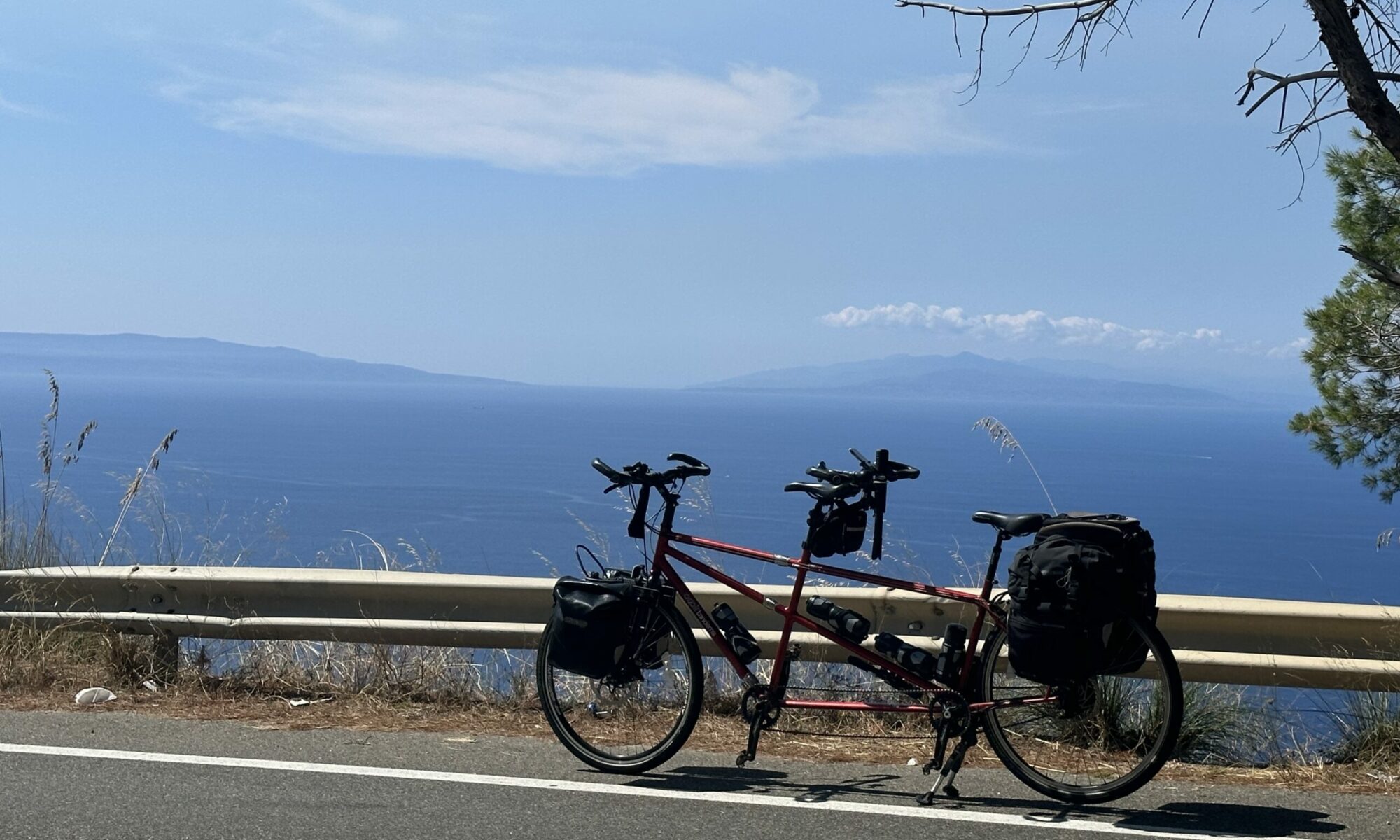Easter Island (Rapa Nui)
As we awaited our flight to Tahiti in Bora Bora’s tiny airport the heavens opened. Almost instantaneously the taxiway was soaking wet. Passengers deplaning from an incoming flight were each given large golfing umbrellas for their short journey between the aircraft and the terminal. Rain poured in torrents from the terminal roof onto the ground. The rain had abated by the time we left on the late evening flight, landing back in Pape’ete at around eight. A long wait was in store, as our flight to Easter Island didn’t leave until three in the morning, so we headed to a nearby Chinese restaurant for our evening meal. They were so efficient that this didn’t use up much time, so we returned to the airport before boarding the plane, yawning heavily, at just after two.
Five hours later, after some sleep, we caught sight of Easter Island, even spotting our first Moai from the air. The runway at Easter Island is a long one (Concorde has even landed there). The lengthening of the runway was paid for by the Americans, who needed a potential backup landing site for the Space Shuttle. When we landed we realised how disproportionately large our Boeing 787 Dreamliner looked in this environment.
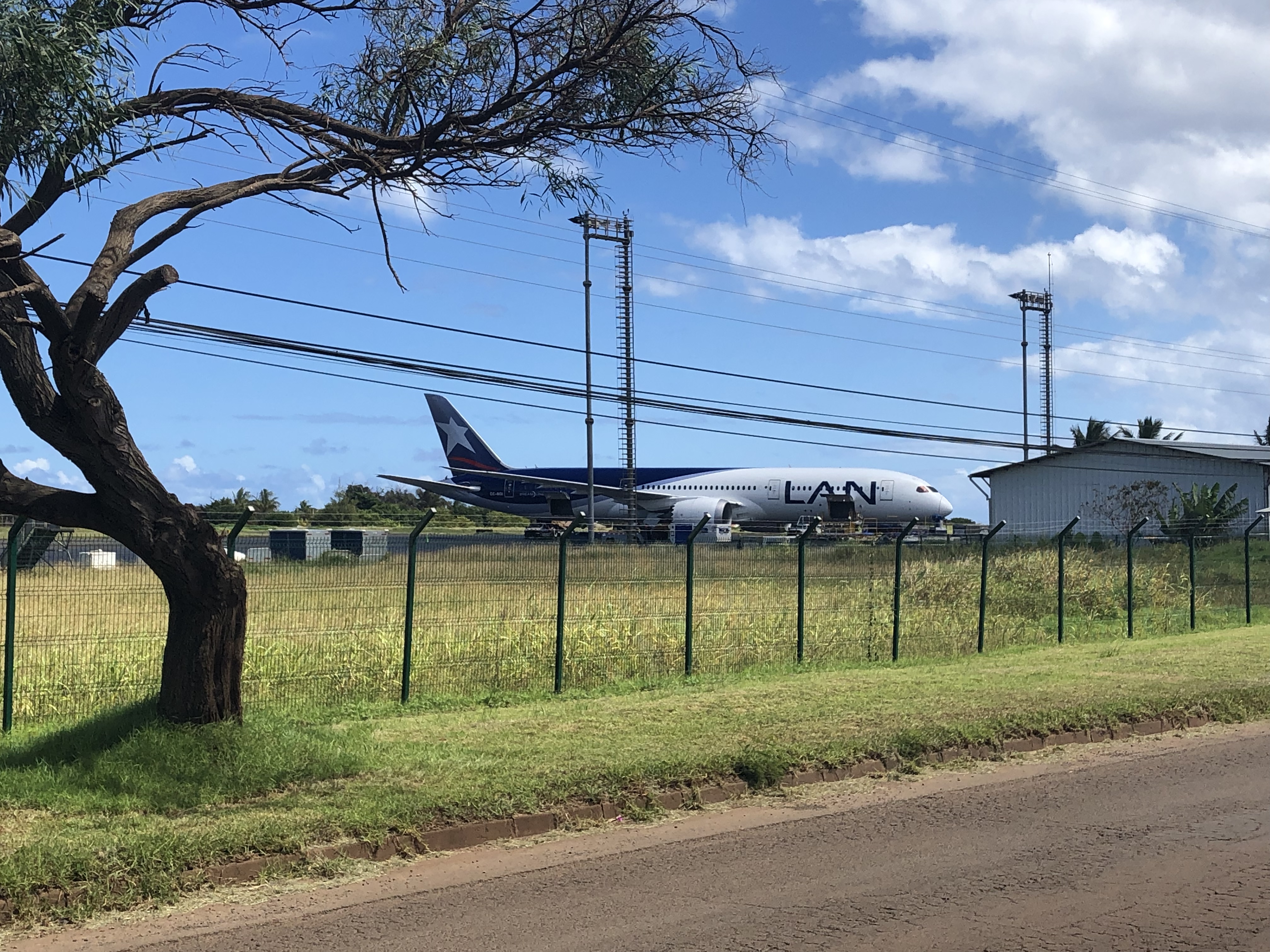
Our hotel, the Puku Vai, is only a few hundred yards from the airport, and was a welcome sight for two rather rumpled and weary travellers. Eschewing the option for an immediate snooze we showered and headed into Hanga Roa to acquire passes for the national park, without which tomorrow’s island tour would be a damp squib. We’re firmly in Spanish speaking territory here, although the greetings in Polynesian are also familiar from Bora Bora – “Ia ora na’ for hello, “Mau’ ururu” for thank you. Hanga Roa is essentially a one-street town, said street running parallel to the sea. There on the shore we found the moai which we had spotted from the plane earlier. The atmosphere in town is laid-back and relaxed. The island only has twenty thousand or so tourists a year, so there is no massive infrastructure required to support such numbers. There’s a refreshing lack of cynicism, too – visitors are greeted with smiling faces and a warm welcome.
With national park passes acquired, cash obtained and with an increasingly weary gait we headed back to our hotel for a rest before dinner. There wasn’t any temptation for us to follow standard dining procedures in Spanish speaking countries by eating really late – we needed to dine before we ran out of matchsticks with which to prop our eyelids open. So we headed for the beach and made what turned out to be a very good choice – Te Moana provided delicious Tempura prawns, then tuna for Clare and steak for me, each accompanied by a different delicious risotto. The sunset, too, was impressive.
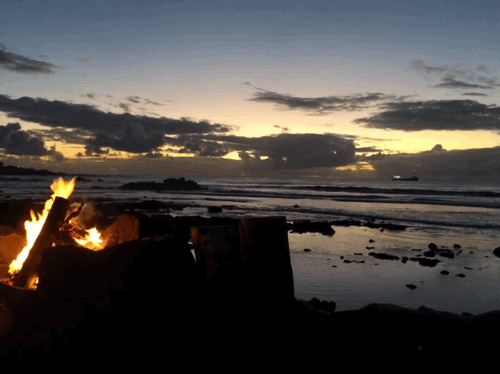
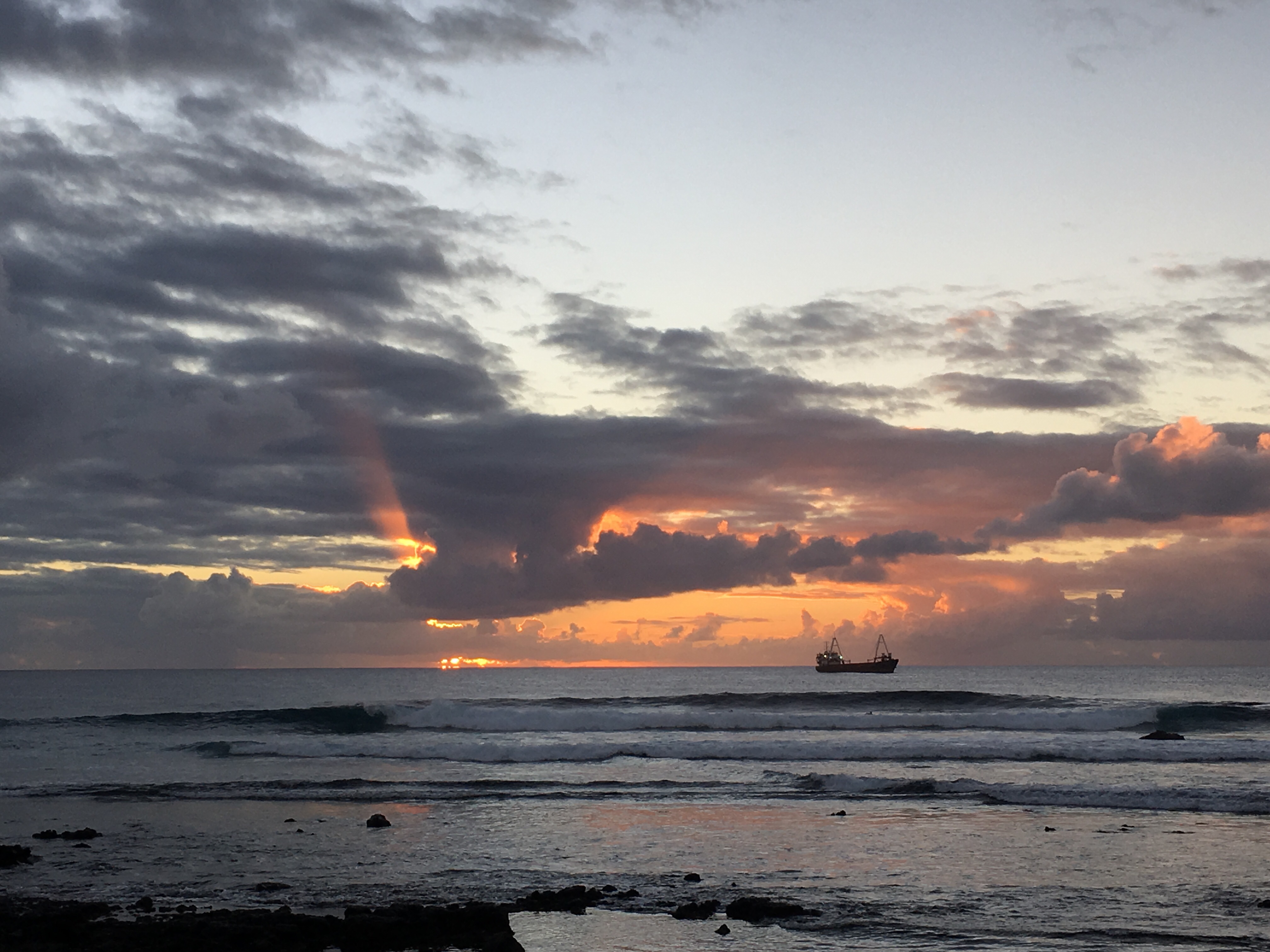
We felt mostly restored after a good night’s sleep – there was some jet lag, perhaps. Our guide for the day, Kava, collected us from the hotel after breakfast. Kava is of mixed Chilean and Rapa Nui heritage, the latter on his mother’s side. This was to prove useful, as it gave him a very interesting perspective on the island’s history. We had discovered (too late!) that people normally tour the island over two days, but as we had only one day at our disposal he promised to cover all of the highlights.
The island is triangular in shape, and only about twelve miles across at the widest point, and it didn’t take long for us to reach the first site, Playa Anakena. What caught the eye first was the beautiful beach, in fact this too was what attracted the first Polynesian settlers.
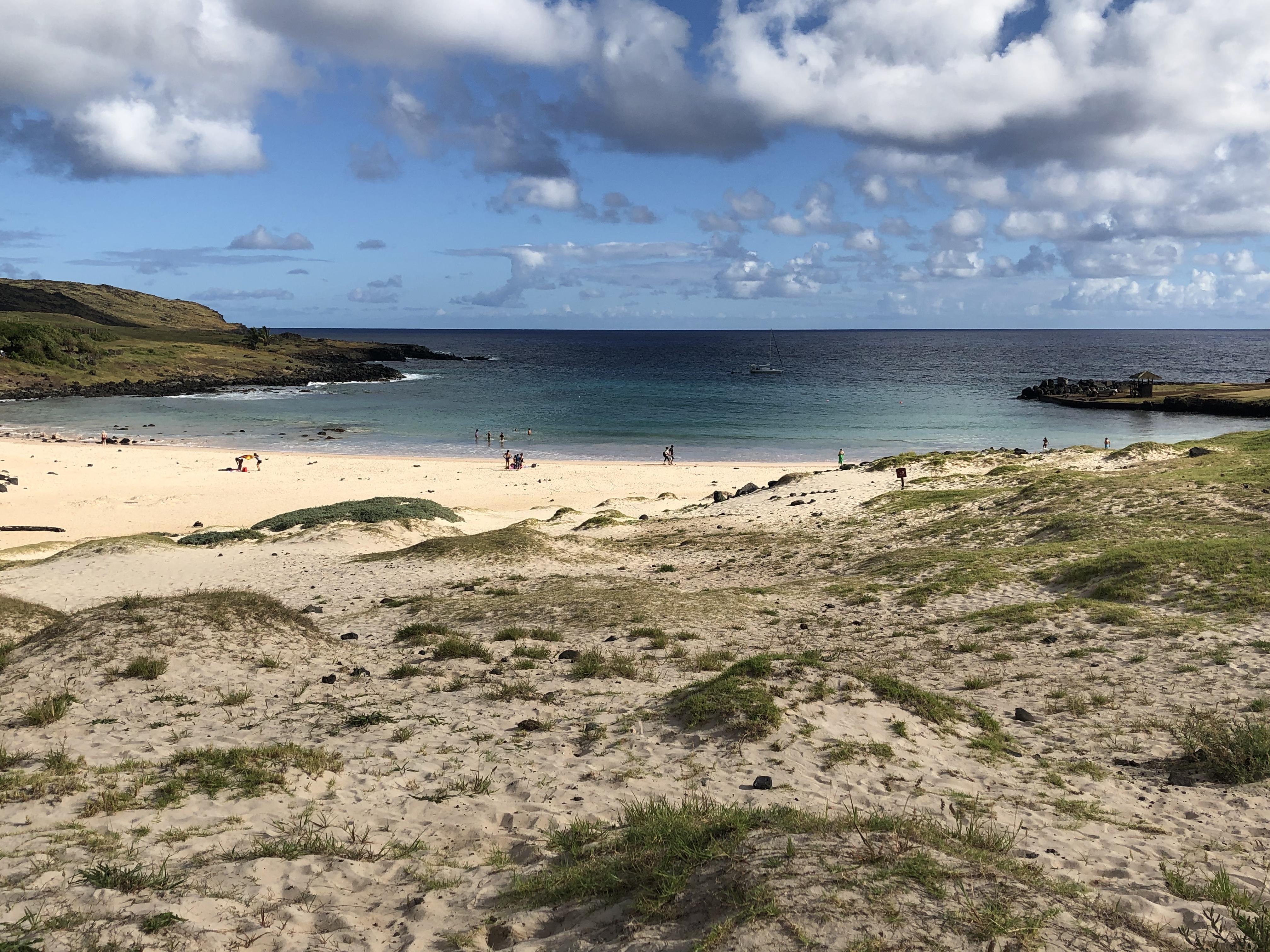
It is the only safe swimming beach, and must have provided the safest entry point for canoes. Parallel to the beach, atop an ahu (ceremonial platform), and facing inland were seven moai. Four of them sported red pukao (topknots).
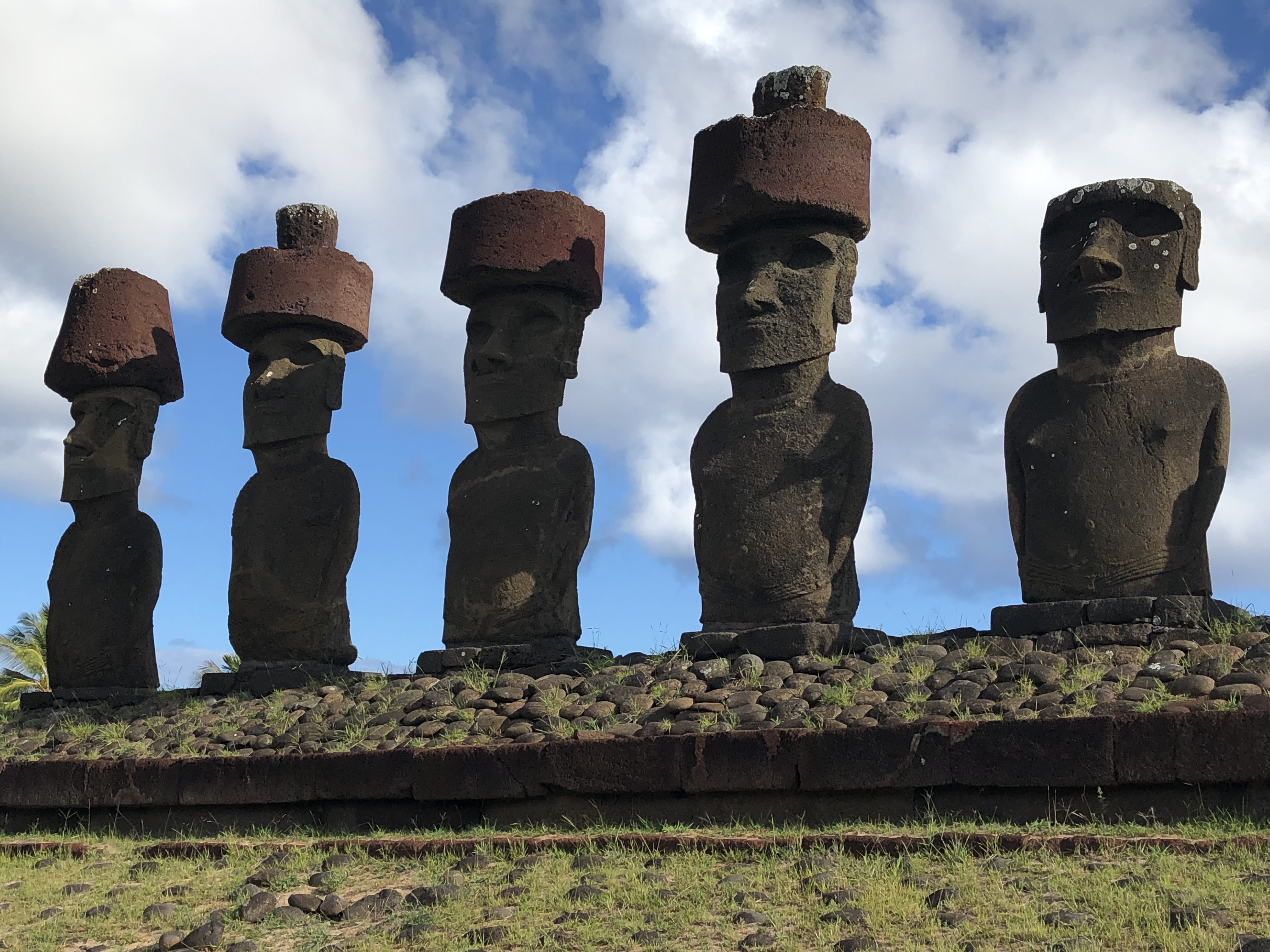
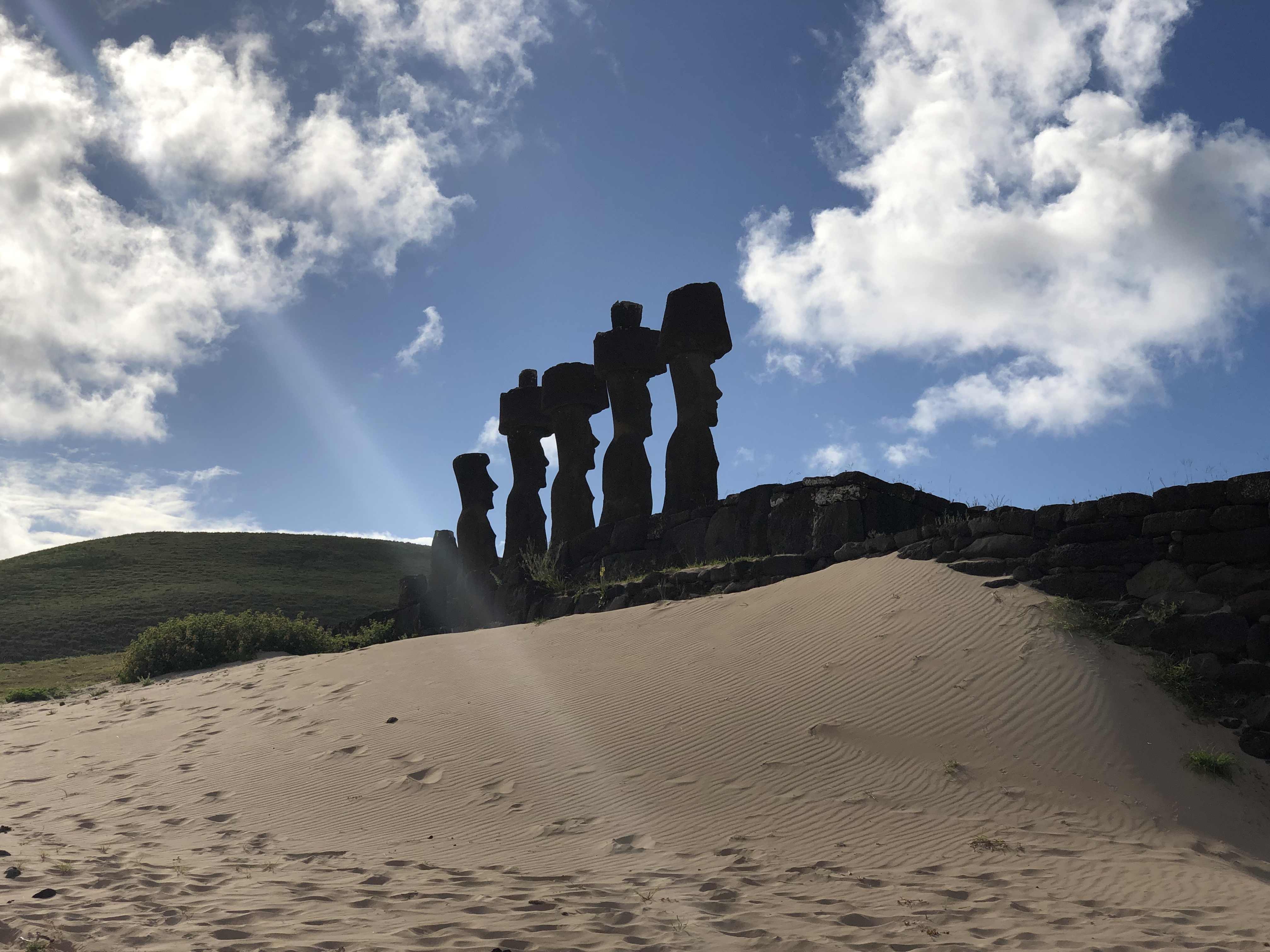
The solemn dignity of the moai was their most impressive aspect. The main body of each moai is of volcanic tuff, the topknots are of red scoria from a different location on the island. Kava described the foundation stories of the Polynesian settlers, led by Chief Hotu Motu’a, who had apparently dreamt of the existence of this remote island. Remote it is, too – apparently the closest habitation is usually the international space station as it passes over.
We moved on to Tongariki, which was more impressive still – fifteen moai, facing away from the sea, implacable and mysterious.

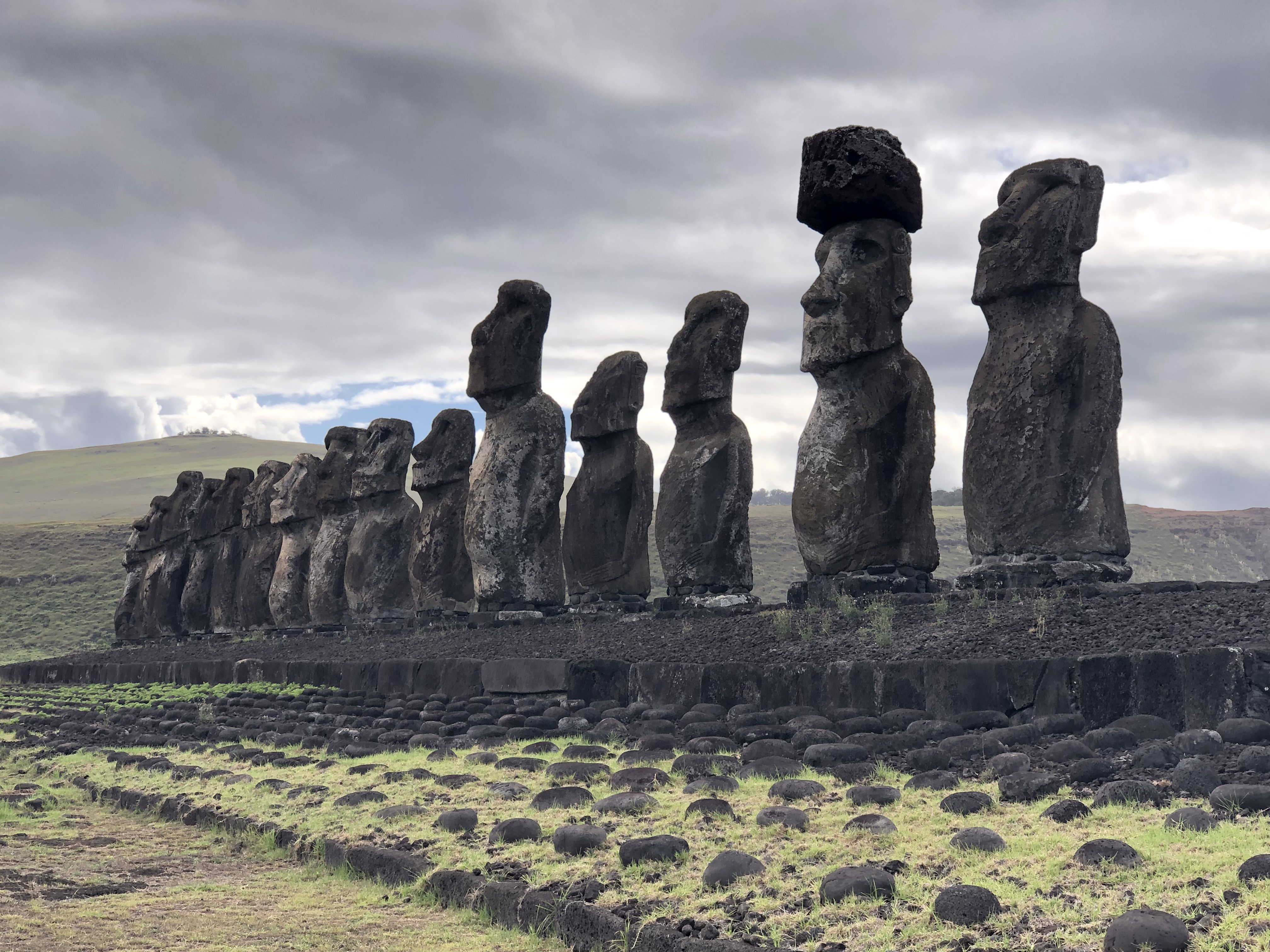
They originally had eyes made of coral (with pupils of obsidian) but their absence made them if anything more dignified, somehow. Both of these sites were almost deserted, and we were able to wander around at a respectful distance, in silent awe of these incredible figures. When we returned, Kava told us of the tsunami which struck here in the nineteen sixties, and how word rapidly spread of the bounty provided by the waves – villagers, including his great grandparents, collected up stranded lobsters and fish from high above the normal shoreline and took it into Hanga Roa for sale.
As we drove on we saw what appeared to be many wild horses by the side of the road. When we asked Kava about these, he said that for most of the time they are allowed to roam freely, but each one is marked, and when the owner needs a horse he will enquire as to its whereabouts.
From time to time, especially as we approached the next site, we saw moai lying on their faces in the earth, or broken into two or more pieces. The reason for this became apparent, as the next site was the tufa quarry where each moai was carved from the rock with hammers made of basalt. This site was fascinating – many figures stood around, perhaps awaiting finishing work, and there were several moai only partially carved from the bedrock.
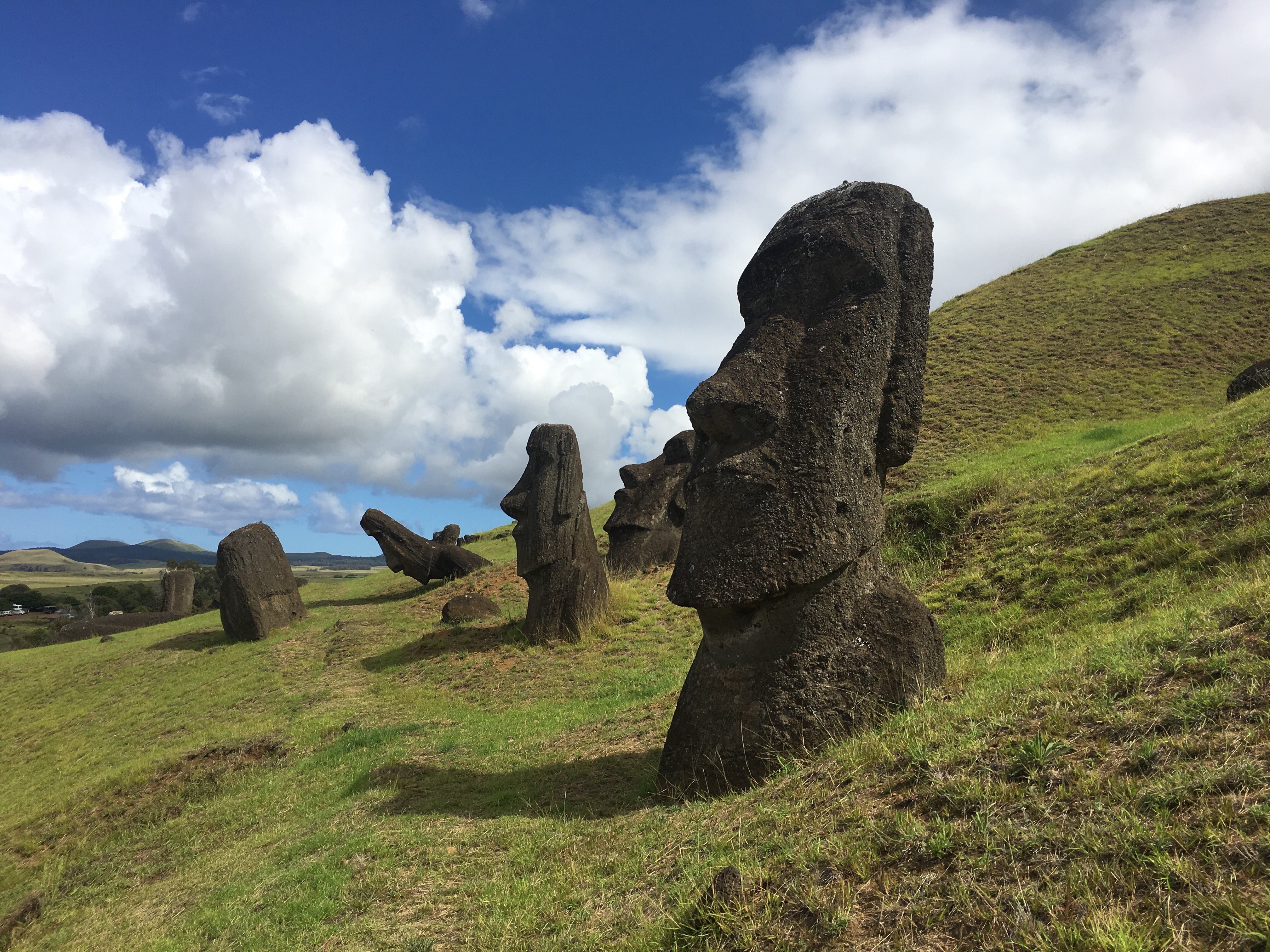
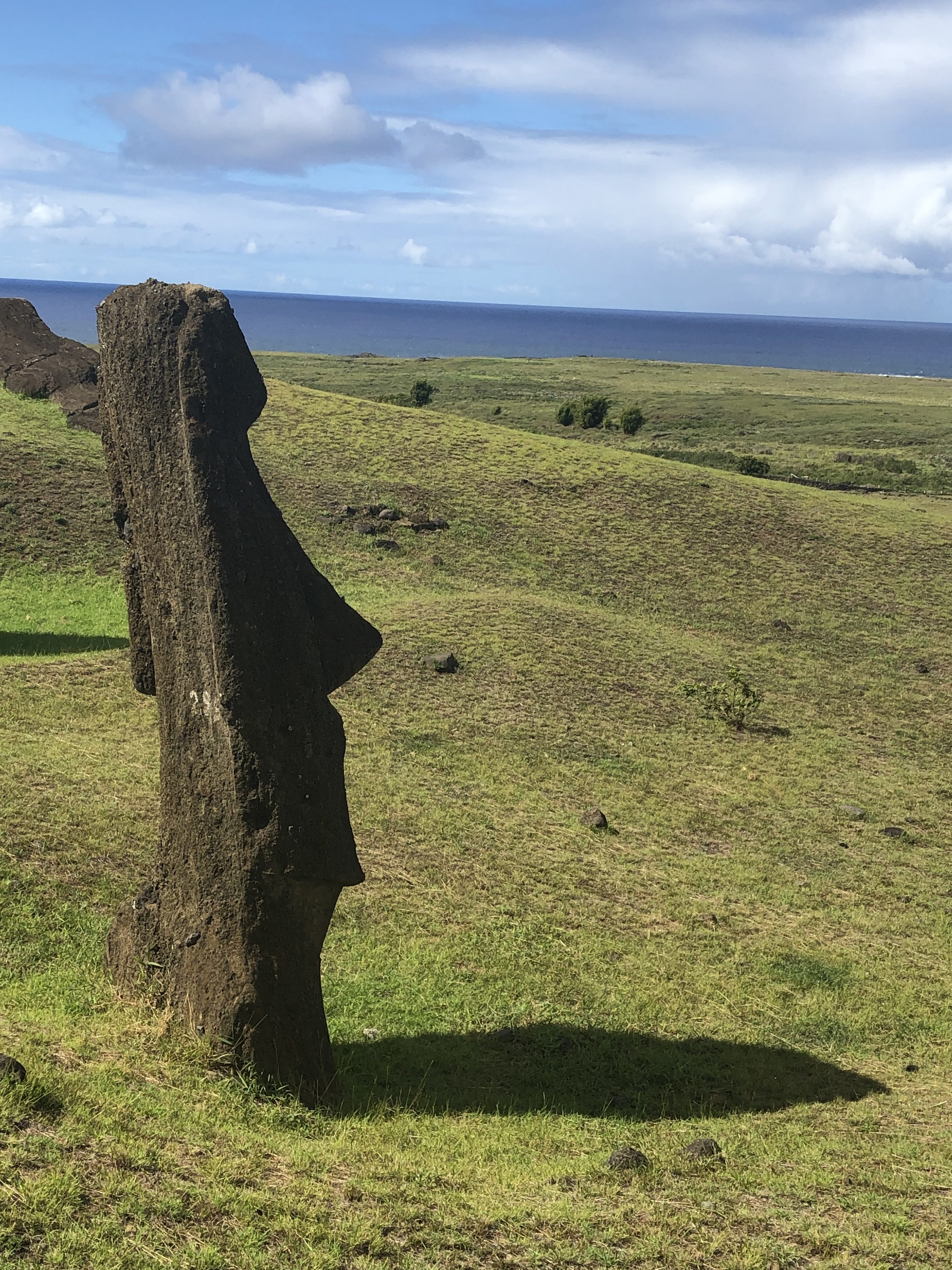
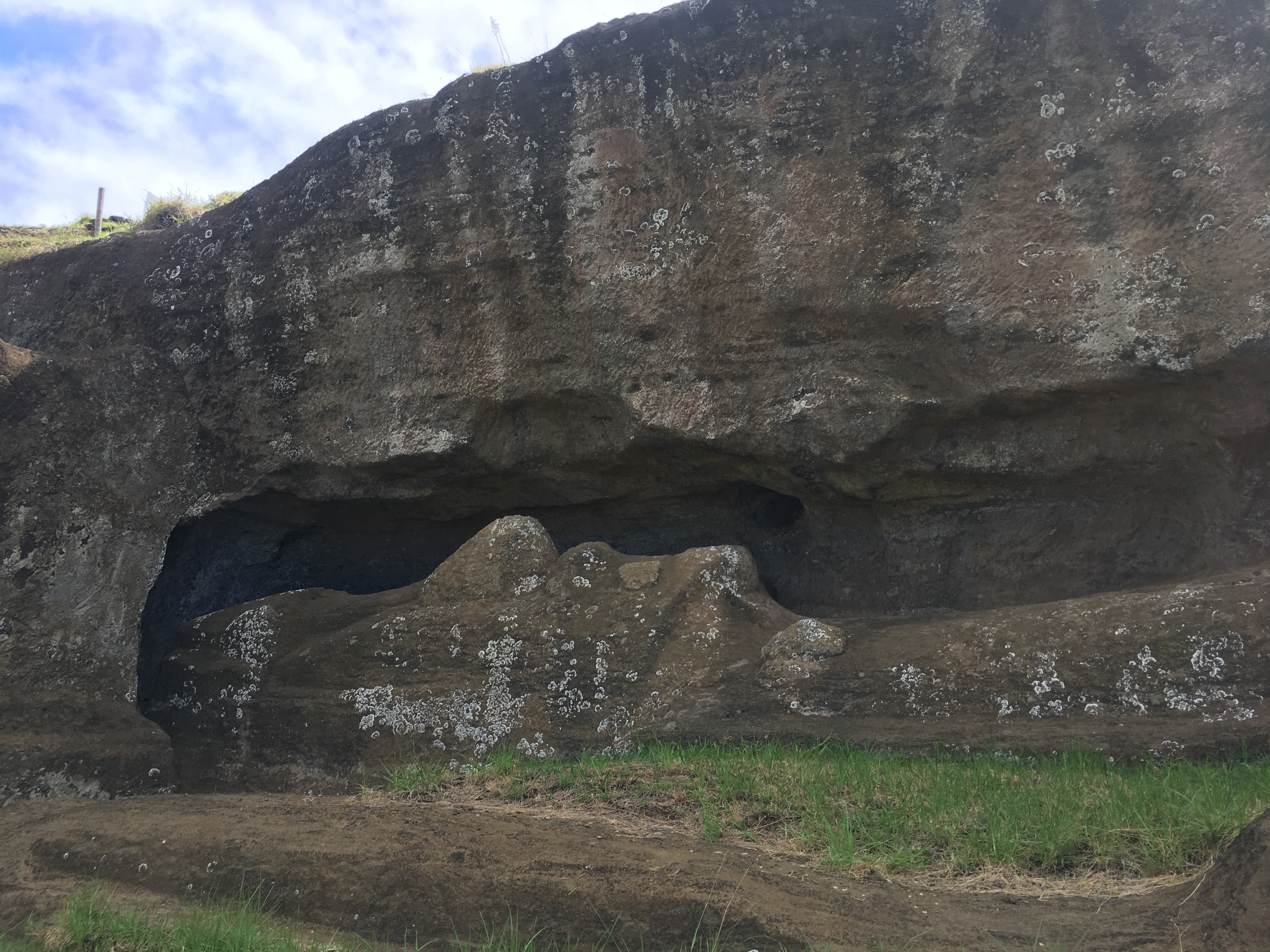
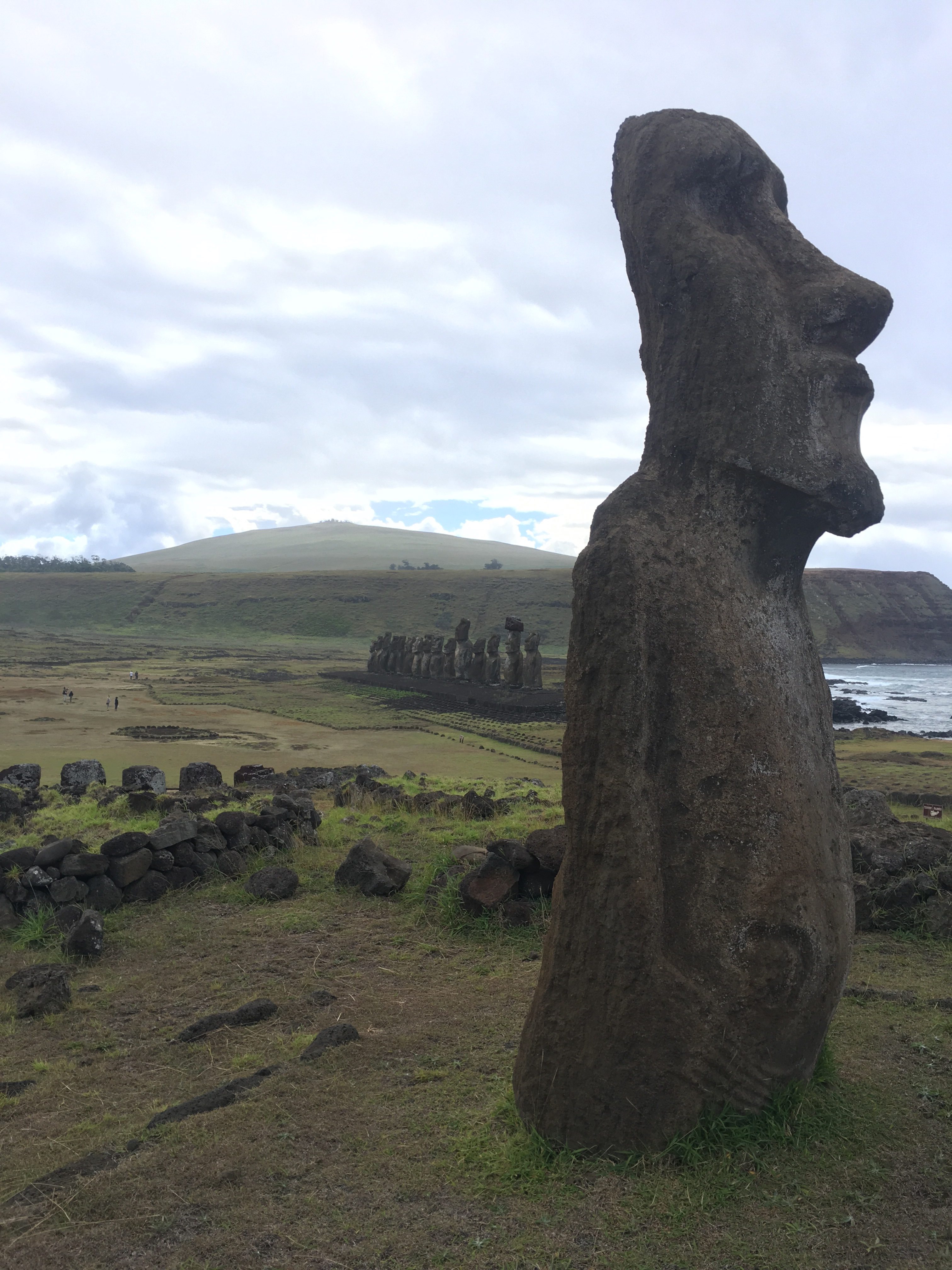
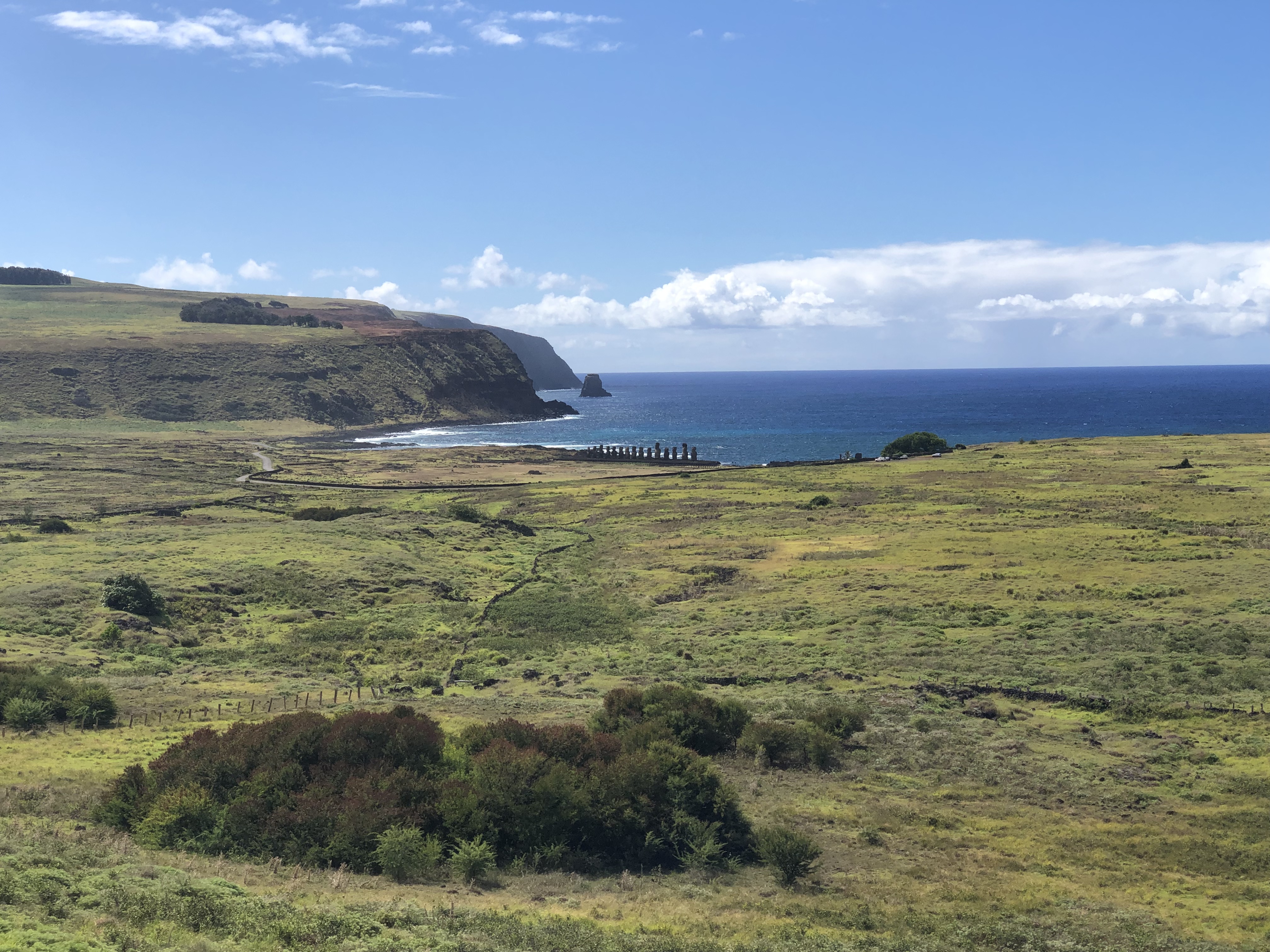
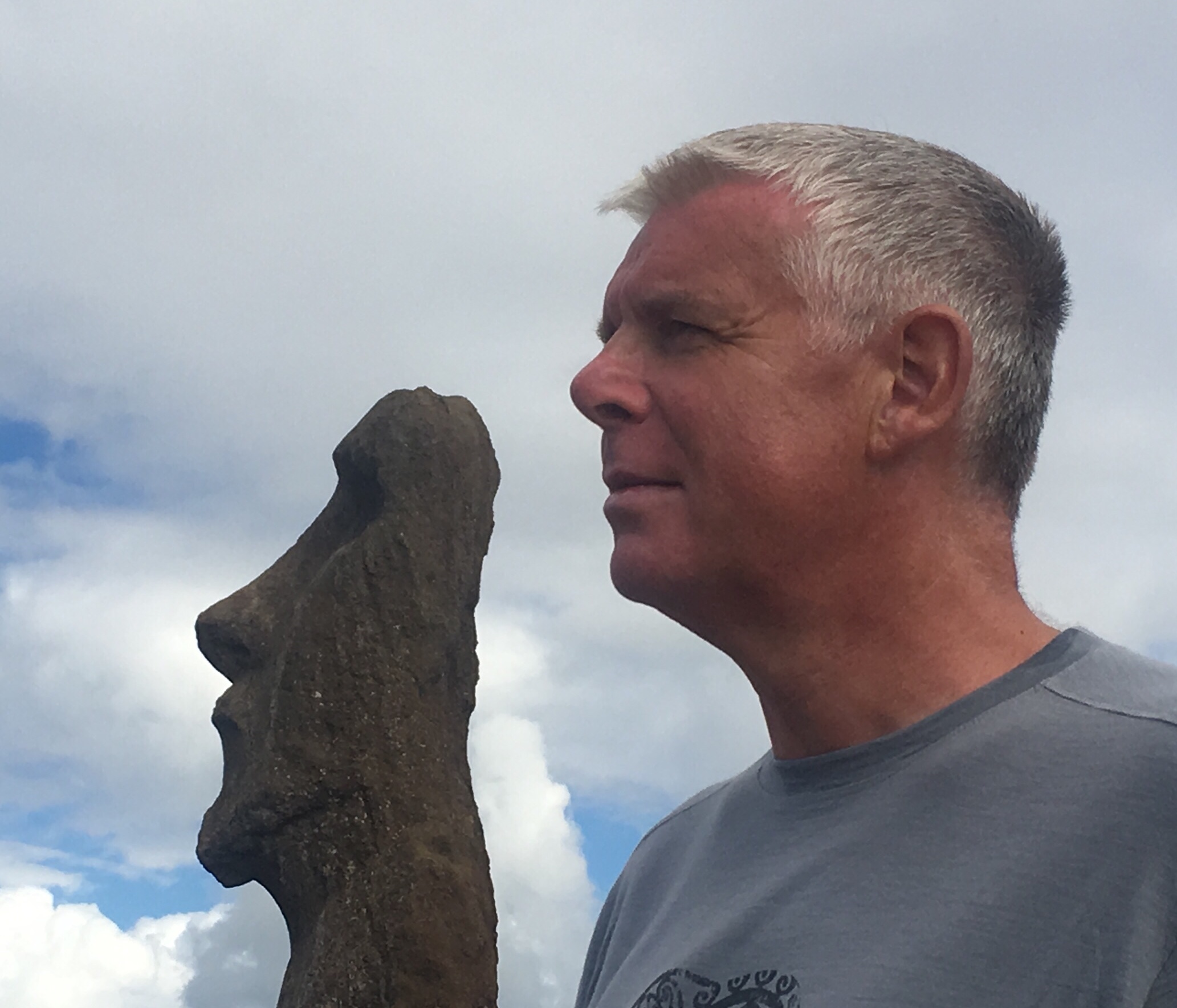
Kava explained that it is thought that the moai were “walked” to their destinations on the island. Before being installed the statues had an inclined base, allowing teams equipped with ropes to shuffle them from side to side on each “foot” and thus to achieve forward motion. Once they reached the destination the base would be squared off, the moai installed on the ahu, the eye sockets carved and the topknot put in place.
As we continued across the island Kava explained the history from the perspective of the Rapa Nui native inhabitants. He was somewhat scornful of the efforts of foreign anthropologists who tried to provide explanations for the mysteries of the island without asking questions of the Rapa Nui people. Amusingly, he described how his great grandfather thought Thor Heyerdahl (who did much research on Rapa Nui, and who he met) was an idiot. He explained that the foundation mythology and histories of the Rapa Nui gave essential clues as to how the moai came to be constructed and were moved to their installed locations. The anthropologists were more interested in formulating theories of their own than in talking to the Rapa Nui. This does indeed seem to be an odd approach. Heyerdahl’s hypothesis that the island was populated from the South American mainland is now broadly dismissed – it is thought that the settlers came from the Marquesas Islands. Apparently, though, DNA testing has also revealed some South American ancestry in the mix.
He told us, too, of the sorry later history of the inhabitants, as catastrophic inter-tribal wars led to drastic depopulation. Peru took many Rapa Nui people to the mainland as slaves, leaving mainly older people behind. When some of the enslaved population were returned to the island they brought smallpox with them. Eventually only 111 Rapa Nui remained on the island. Over time there has been significant recovery, with Rapa Nui people now forming about half of the island’s population. We visited a small reconstruction of a typical Rapa Nui village.
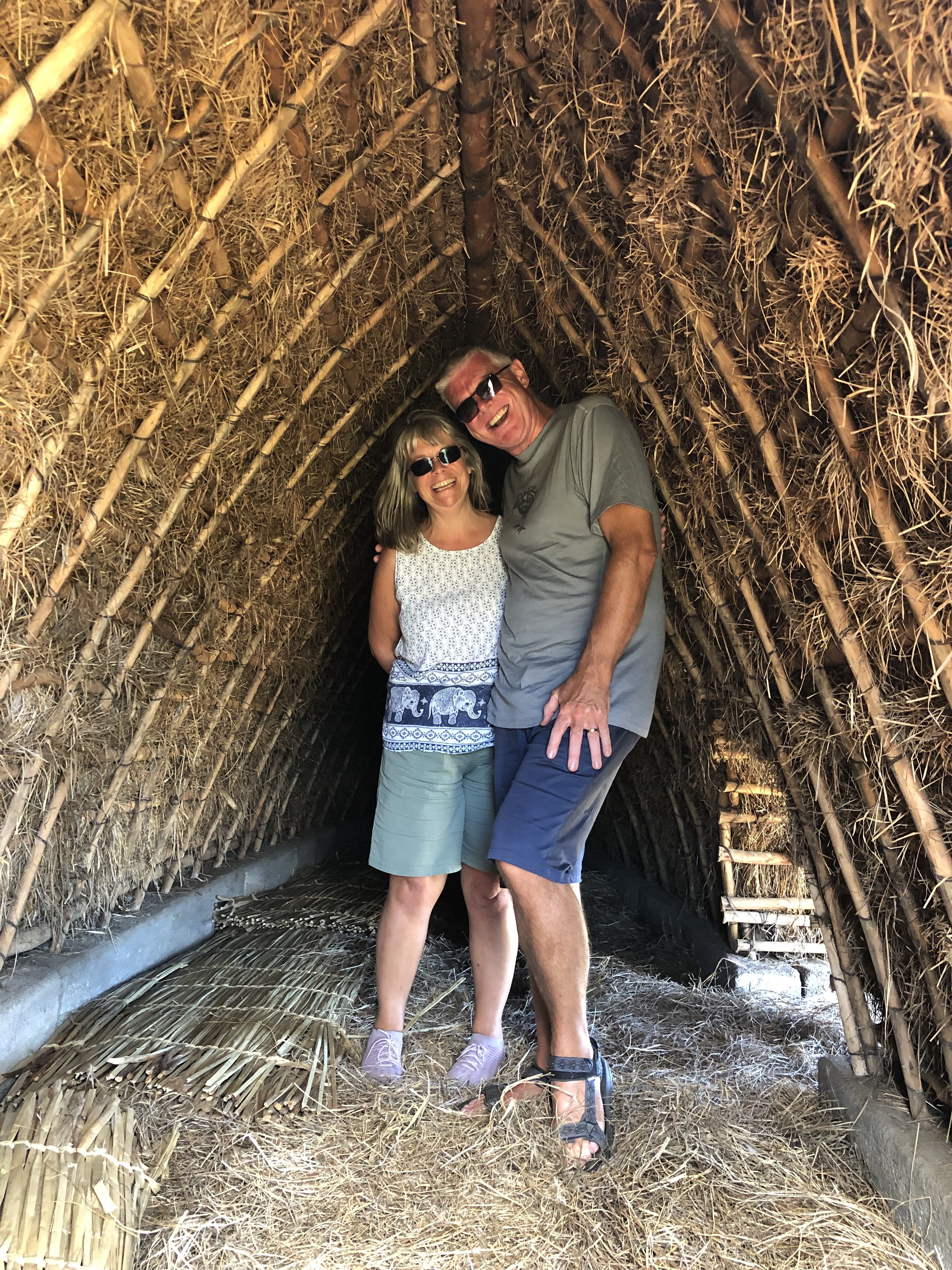
Our tour continued to Ahu Akivi, a ceremonial site and cremation ground, where seven solemn moai stared (unusually) out to sea.
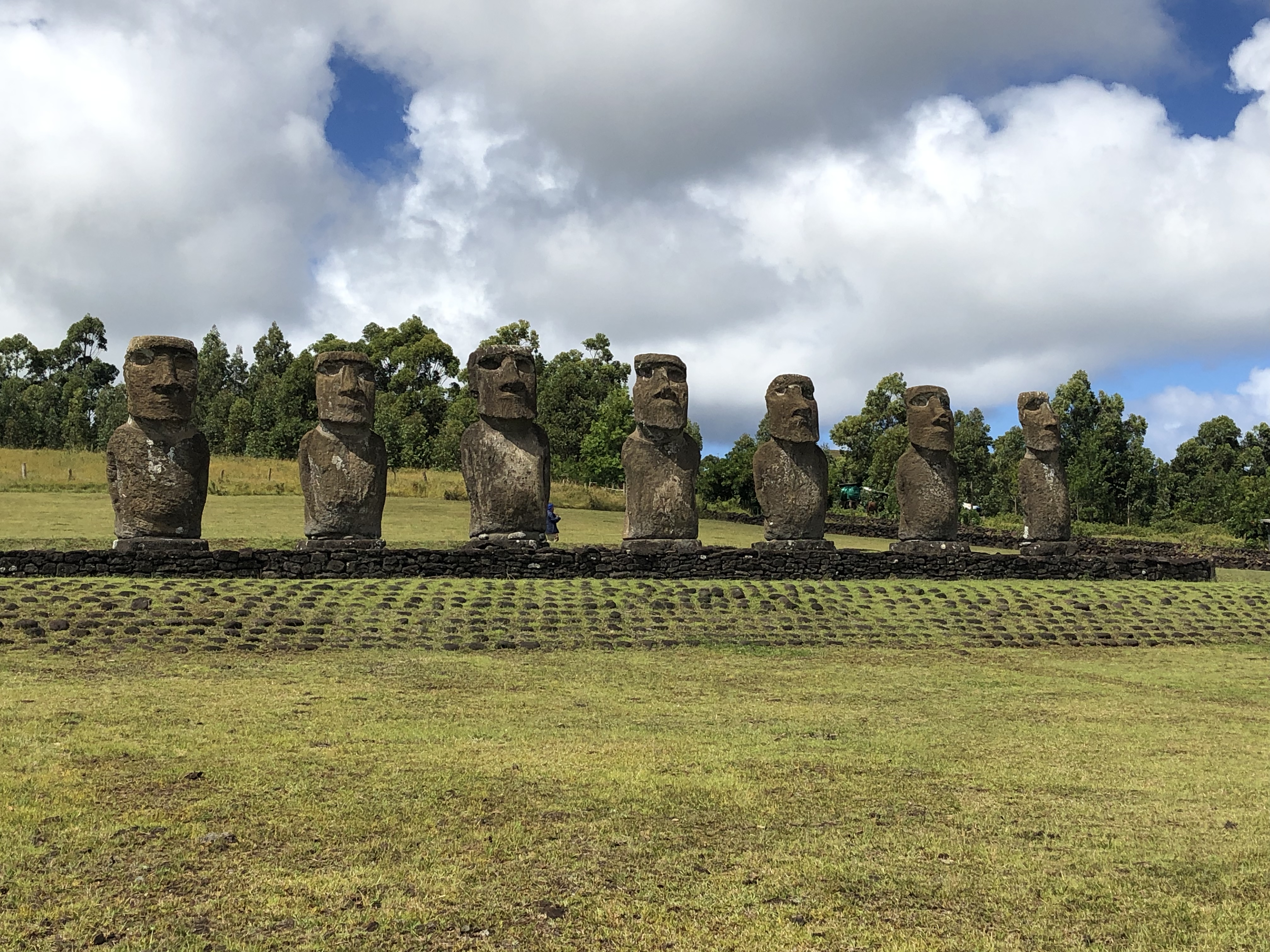
Apparently, the inter-tribal wars involved attacking these sites and pushing over the moai of rival tribes. Eventually not a single one of the thousand or so moai on the island was still standing, and this remained the case until later restoration, initially by the Japanese, and later by western anthropologists. Kava told us of the time he came to this site with some Māori visitors. One of the Māori, from the Waitangi tribe, gazed at the moai, breathed in, exhaled slowly and thanked Kava for having brought them to this site. “We have stories of this place”, he said.
The tribal wars continued until the curious emergence of a new cult, which co-existed with the moai. Later moai (including the one filched by Britain, now in the British Museum) feature birdman petroglyphs carved into the back. In order to explain the birdman cult further, Kava took us to the Rano Kau volcano.
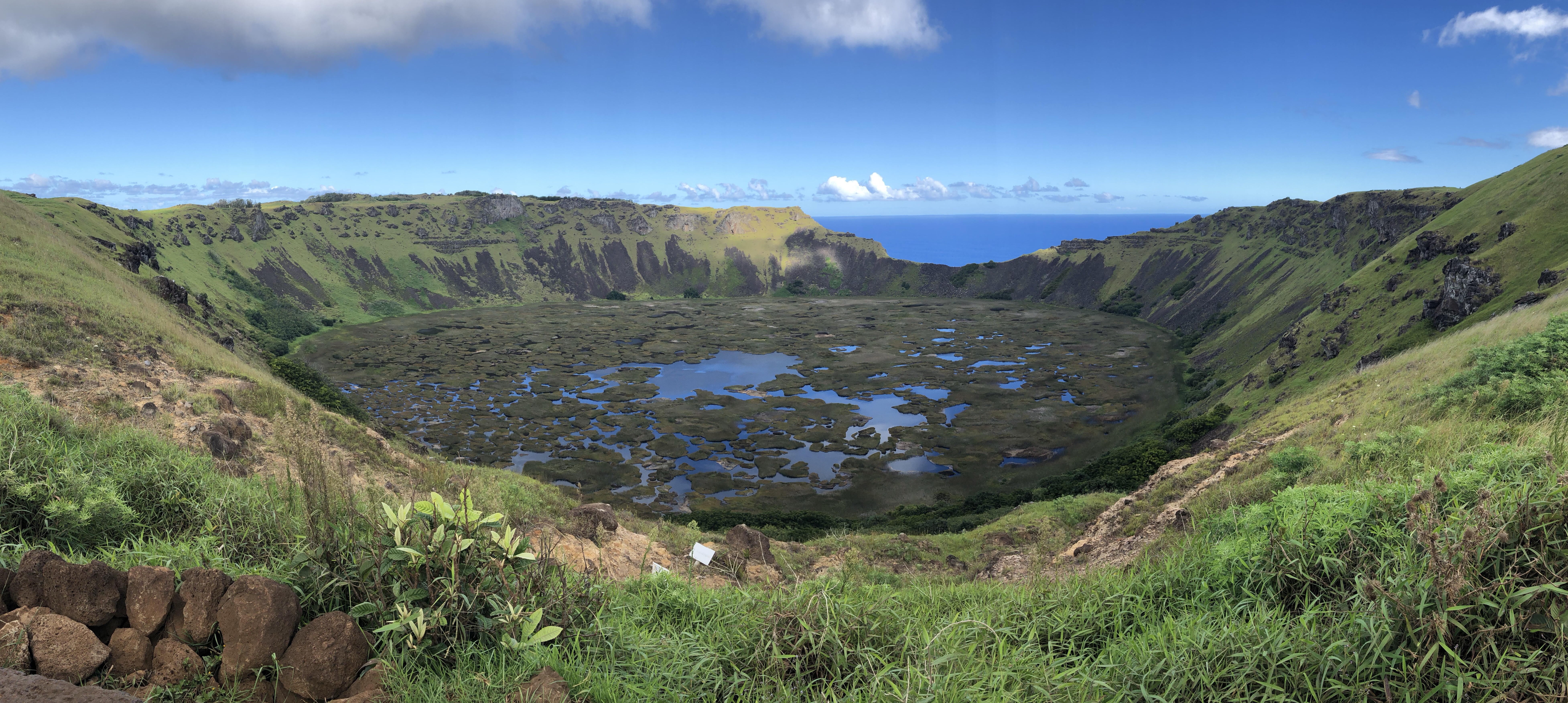
Here, high on the rim of the volcano the last historic village of the island bore witness to an annual competition, where the brave (or foolhardy) villagers descended steep cliffs and swam long distances in the sea out to three small neighbouring islands, in search of eggs from the Sooty Tern (which visits these islands for nesting each year).
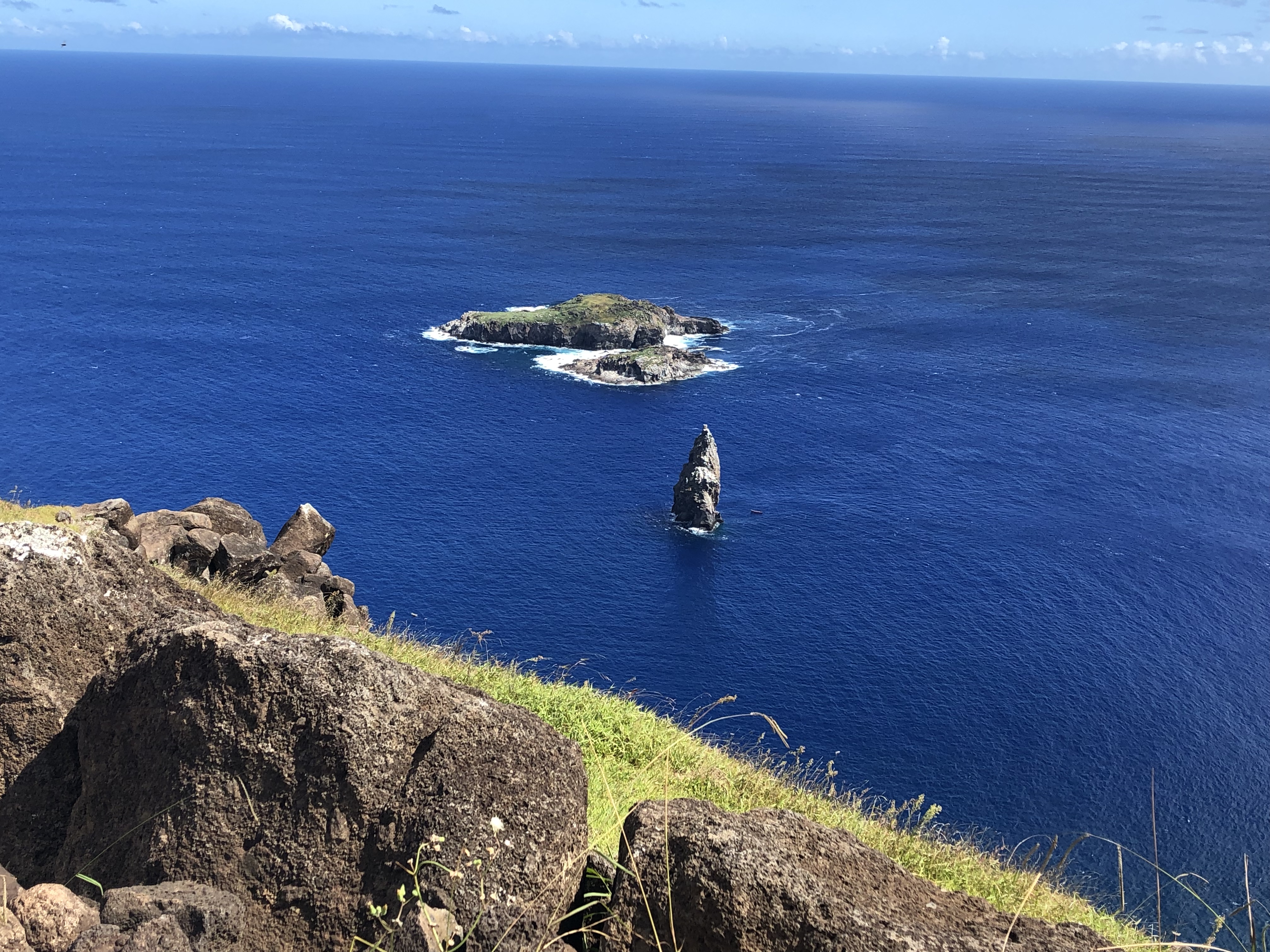
The aim was to retrieve an egg, store it for safe-keeping in your top-knot, climb back down into the sea, swim back to the shore and climb up to the village. The first man back with an egg became the “birdman” for the year, granting his chief power over the village.
After hearing the end of this story we walked through the village, past the location where the only surviving moai made of basalt was originally placed. This was the one taken by the British. Kava explained that he was happy that the moai was well preserved, but it made him and his fellow Rapa Nui people incredibly sad that there was a moai (an important one, at that) he would probably never see.
What a day. It’s hard to convey the impression left on us by the moai. They are an implacable, dignified presence throughout the island, and so much of the history and mythology behind them has been lost. We’re so glad that we came here.
Our evening was spent at another restaurant on the shoreline, enjoying the sunset, drinking Chilean Carmenere and eating excellent local food.
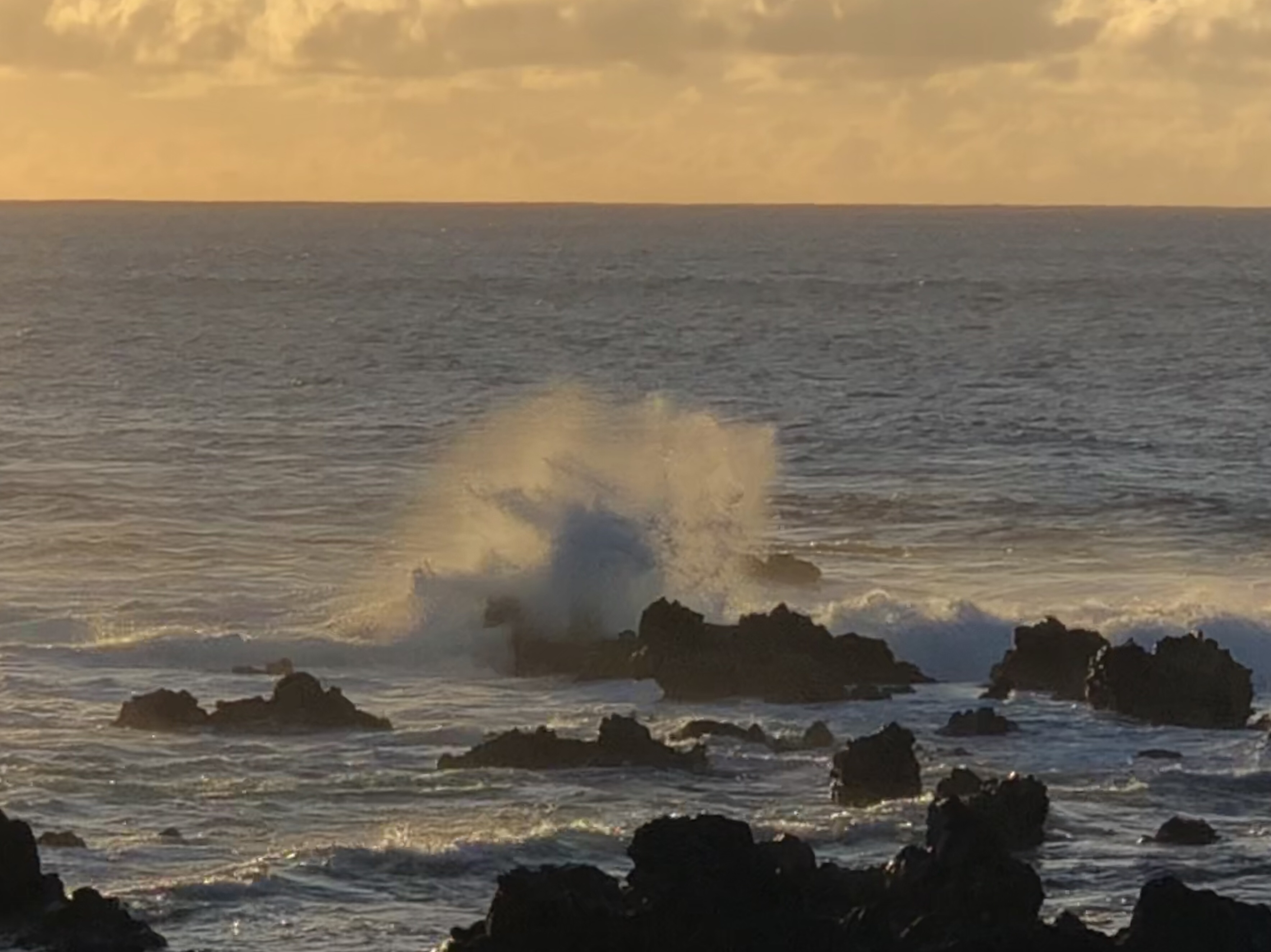
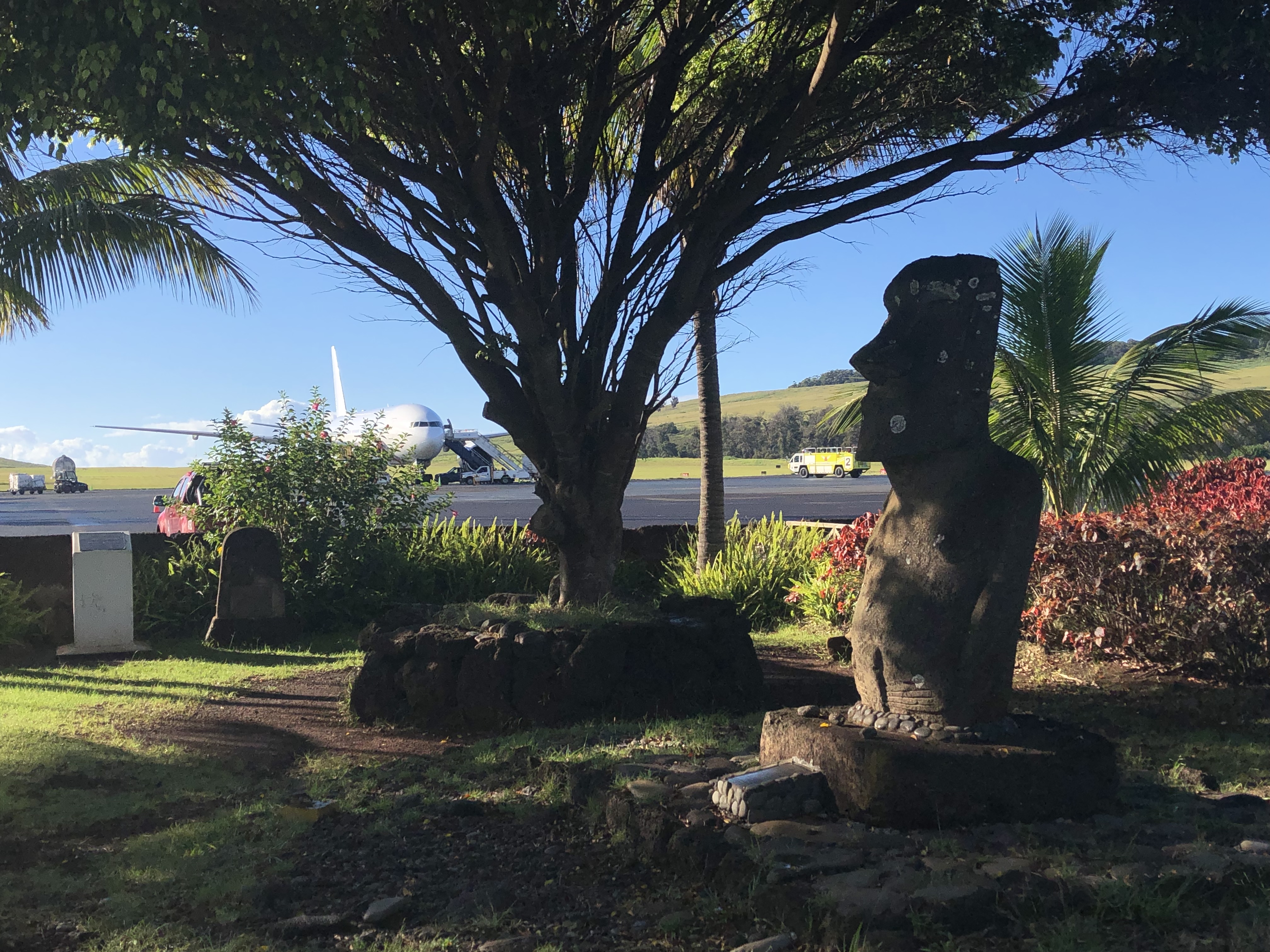
We’ve only had one full day here, but we will remember it for as long as we live, I am sure.
Santiago, Chile
Another five hour flight brought us to the South American mainland. For both of us it’s our second new continent of the trip, and for me it leaves only Antarctica unvisited (I suspect that will remain the case!). As we descended, blue seas gave way to an arid hilly landscape in various shades of red and brown, and in the distance we could see the mountains and glaciers of the high Andes.
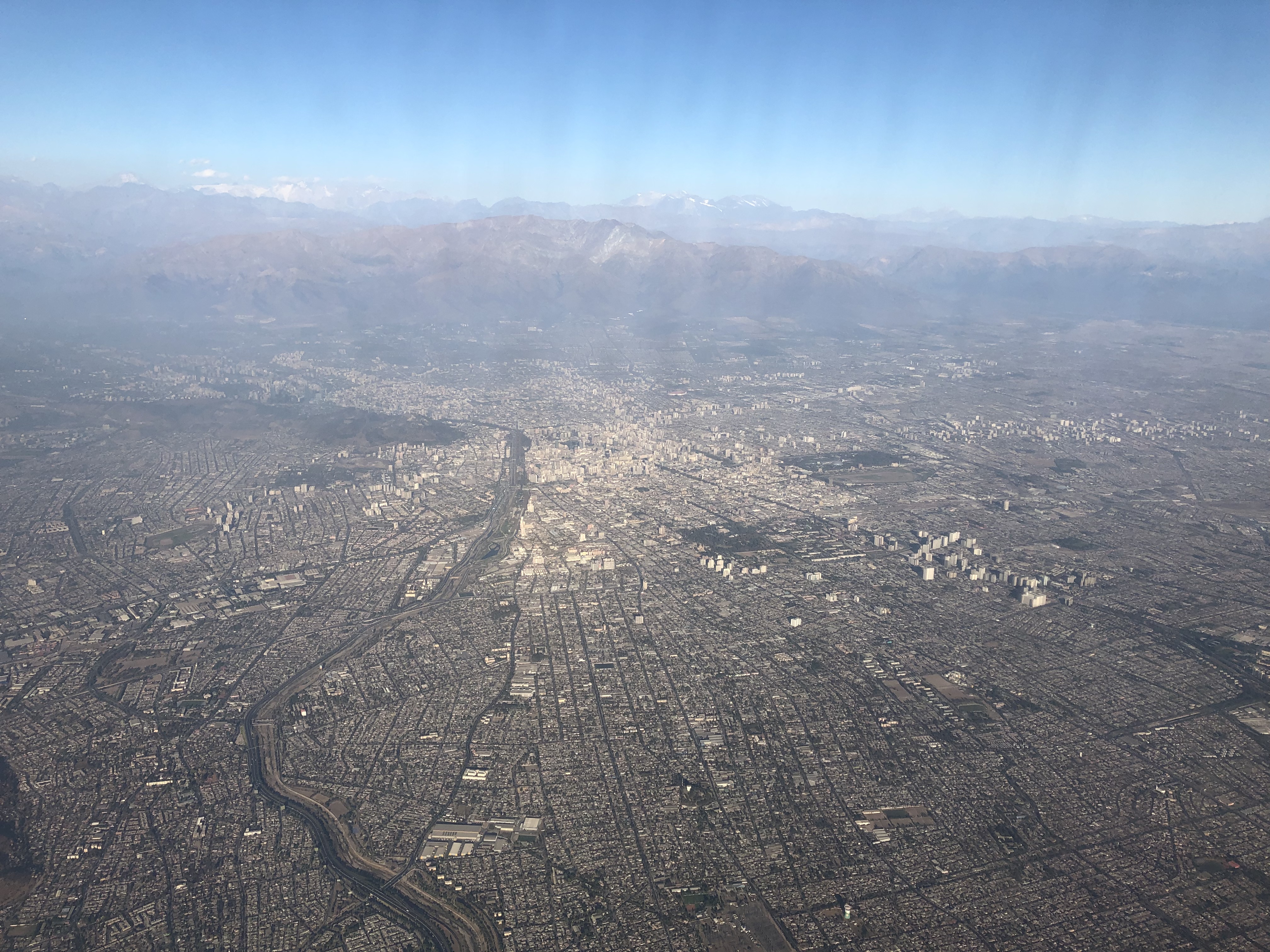
As we headed north of the city in order to line up for the airport Clare spotted Aconcagua, the Southern hemisphere’s highest mountain, from the plane window.
Our first full day in Chile ended up being a lazy start. I wouldn’t go as far as to say we were suffering from full-blown jet-lag, but there was a five hour difference between Tahiti and Easter Island, and then a further two hour difference between Easter Island and Chile, so we did feel a little out of sorts. So we headed out just before lunchtime on foot, initially to the Plaza de Armas, to admire the beautiful historic architecture of the public buildings in Santiago’s main square. Then we headed north-east towards San Cristóbal.
It was nearly lunchtime, but our first mission was to find me a hat. Colin, (Clare’s brother) is diligently preparing our agenda for Brazil (where he lives), and says that a wide-brimmed hat will be essential during our travels there. With the help of Google we located a shop called Sombreros Delpiano. Now for those of a certain age such as ourselves, Sombreros were the ridiculous hats brought back by those who had visited the Spanish Costas. We took the gamble that it really just meant hats, and fortunately our gamble paid off. I have quite a big head (no, really ????) so we had to cast around for hats of a suitable size, but eventually we settled on a very elegant off-white number.
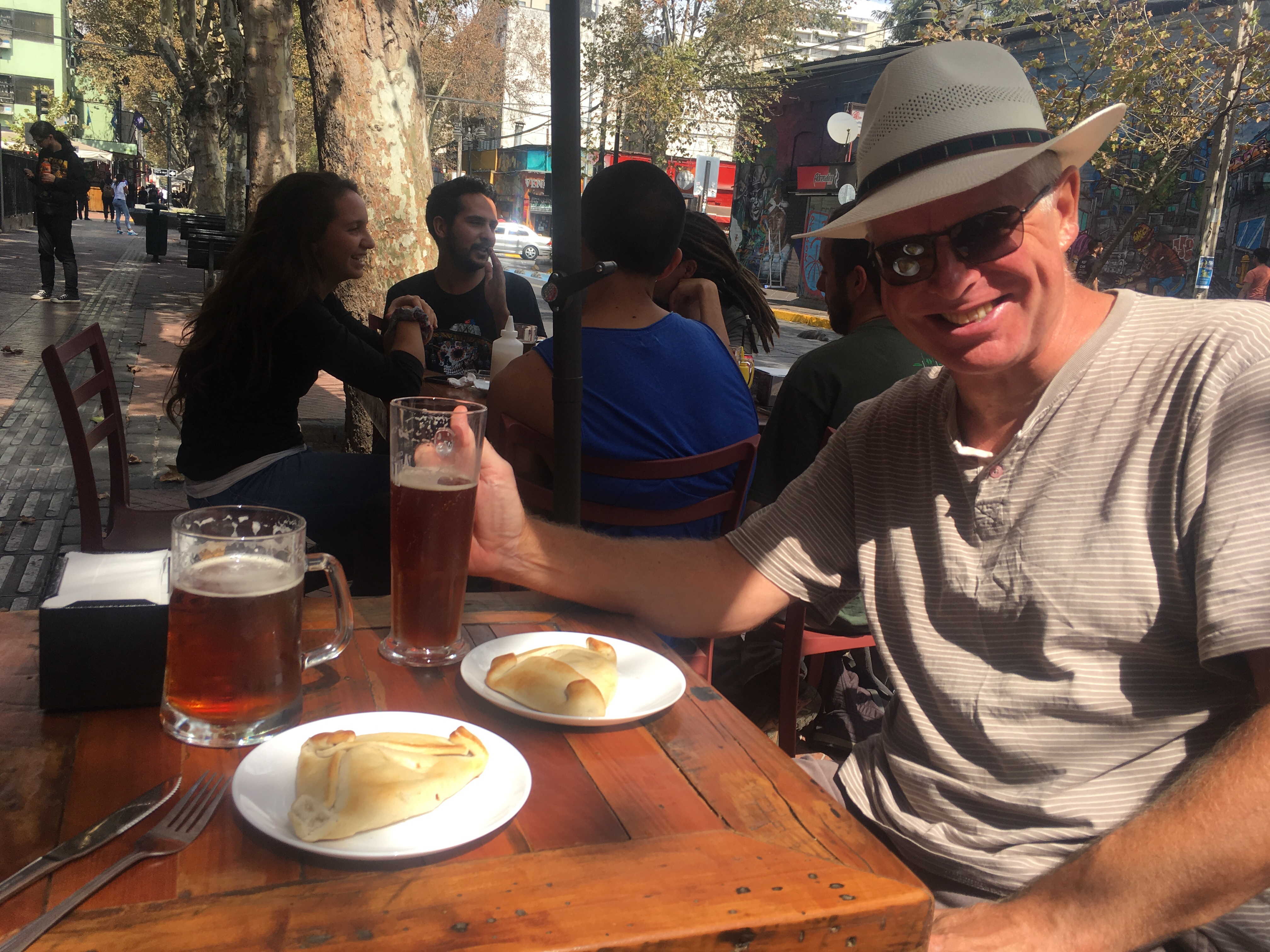
We lunched on empanadas and delicious cold beer before heading up the funicular to the Sanctuary at the top of the San Cristóbal hill.
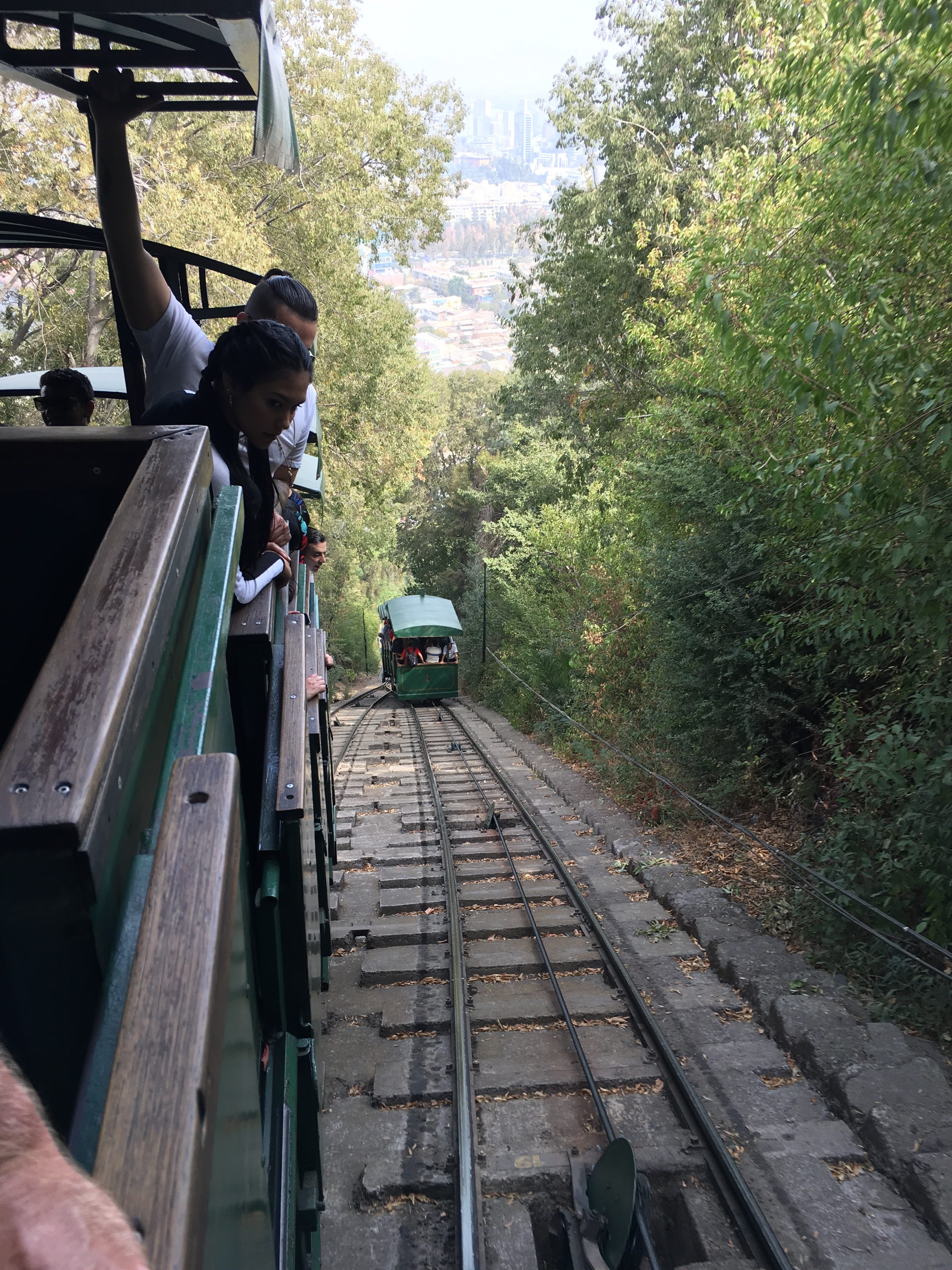
We do love a funicular, and this one was no exception. At the top the views were extensive, if dulled somewhat by the haze of pollution caused by Santiago’s location on a plain between mountain ranges. The sanctuary was impressive, and also featured the mandatory sleeping dog just outside.
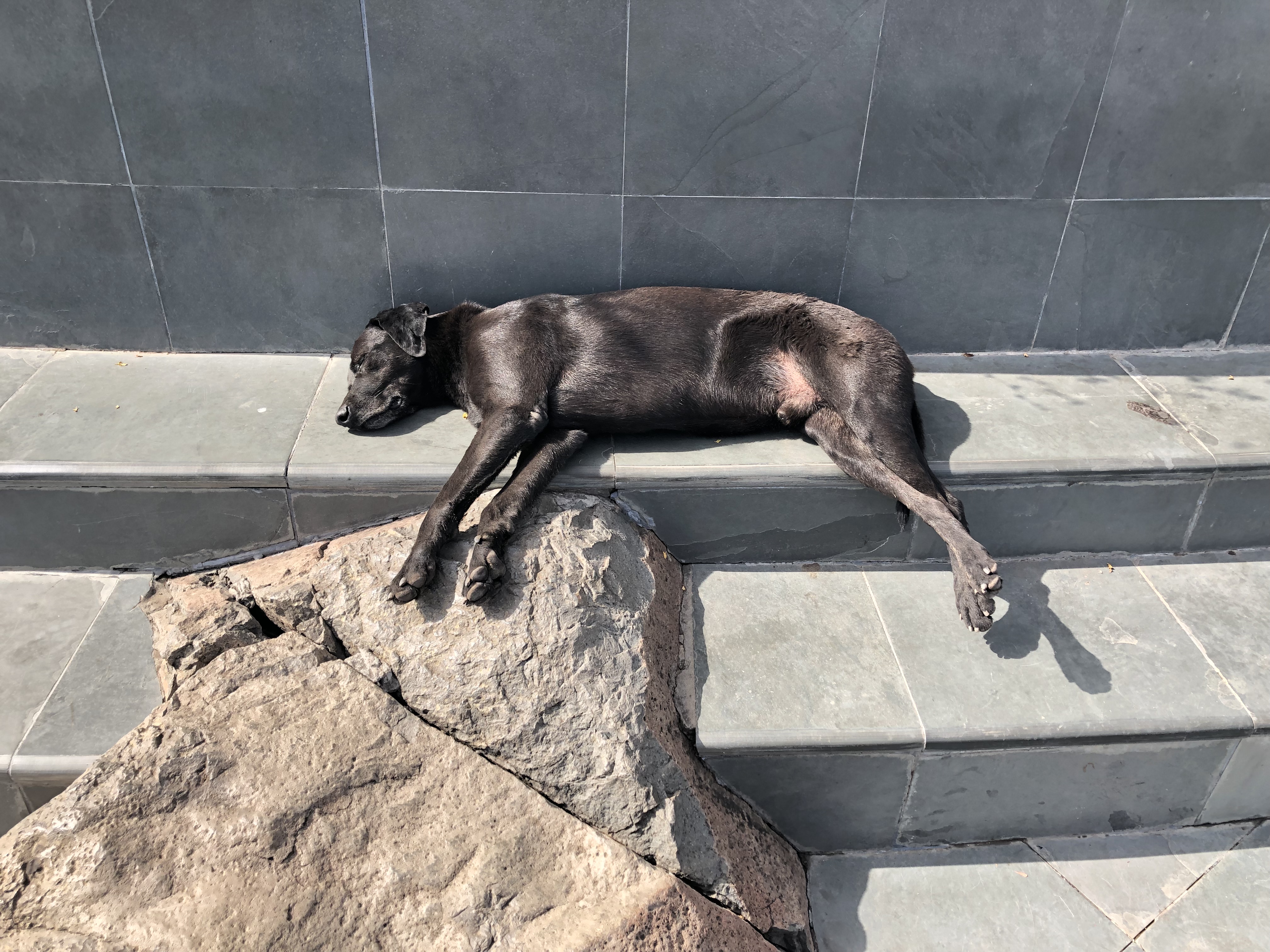
From there we hopped into a gondola cabin with two Argentinian gentlemen for a twenty minute journey along the ridge and then back down towards the city centre. Santiago is huge, and continues in all directions for some distance.
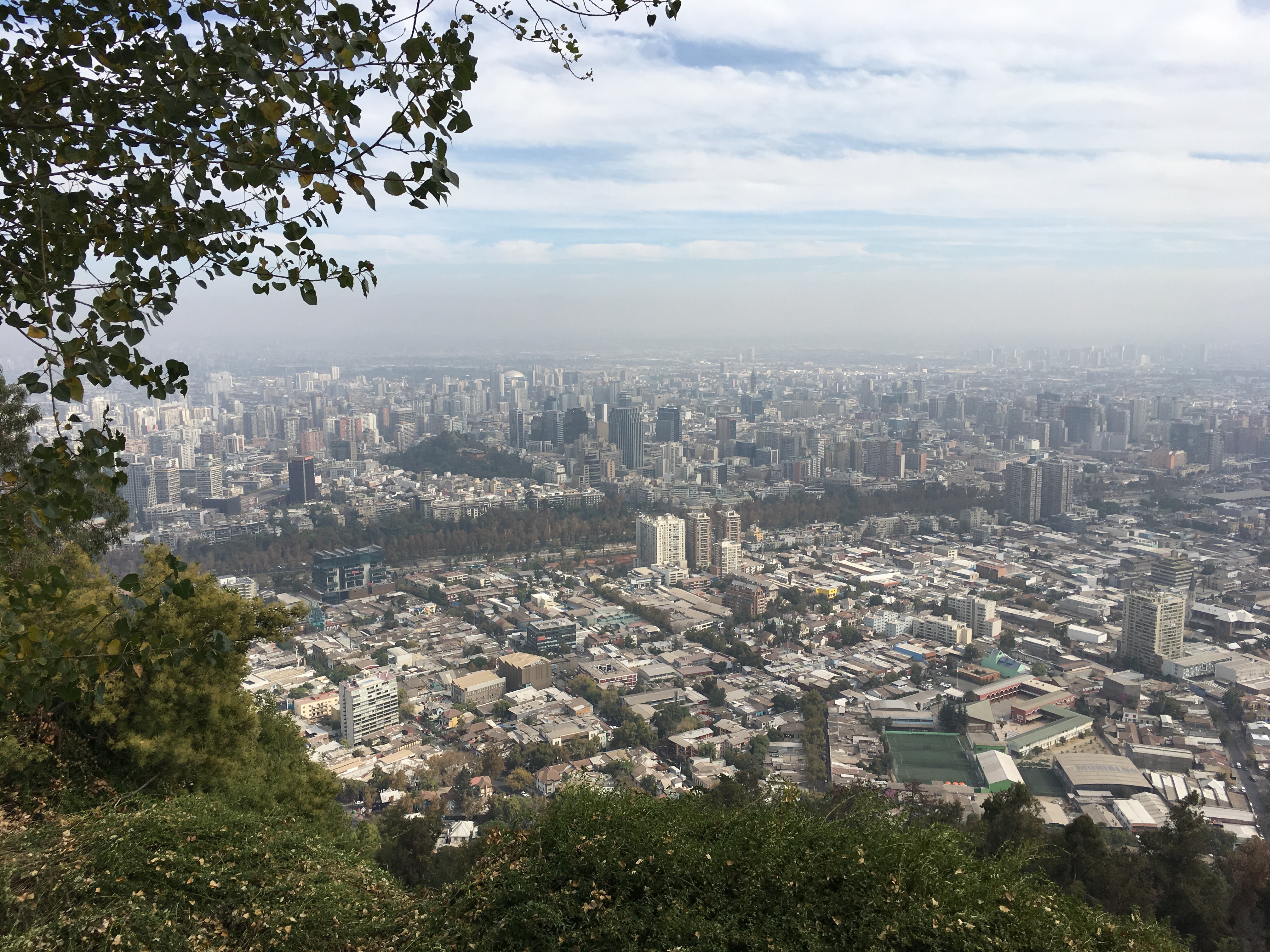
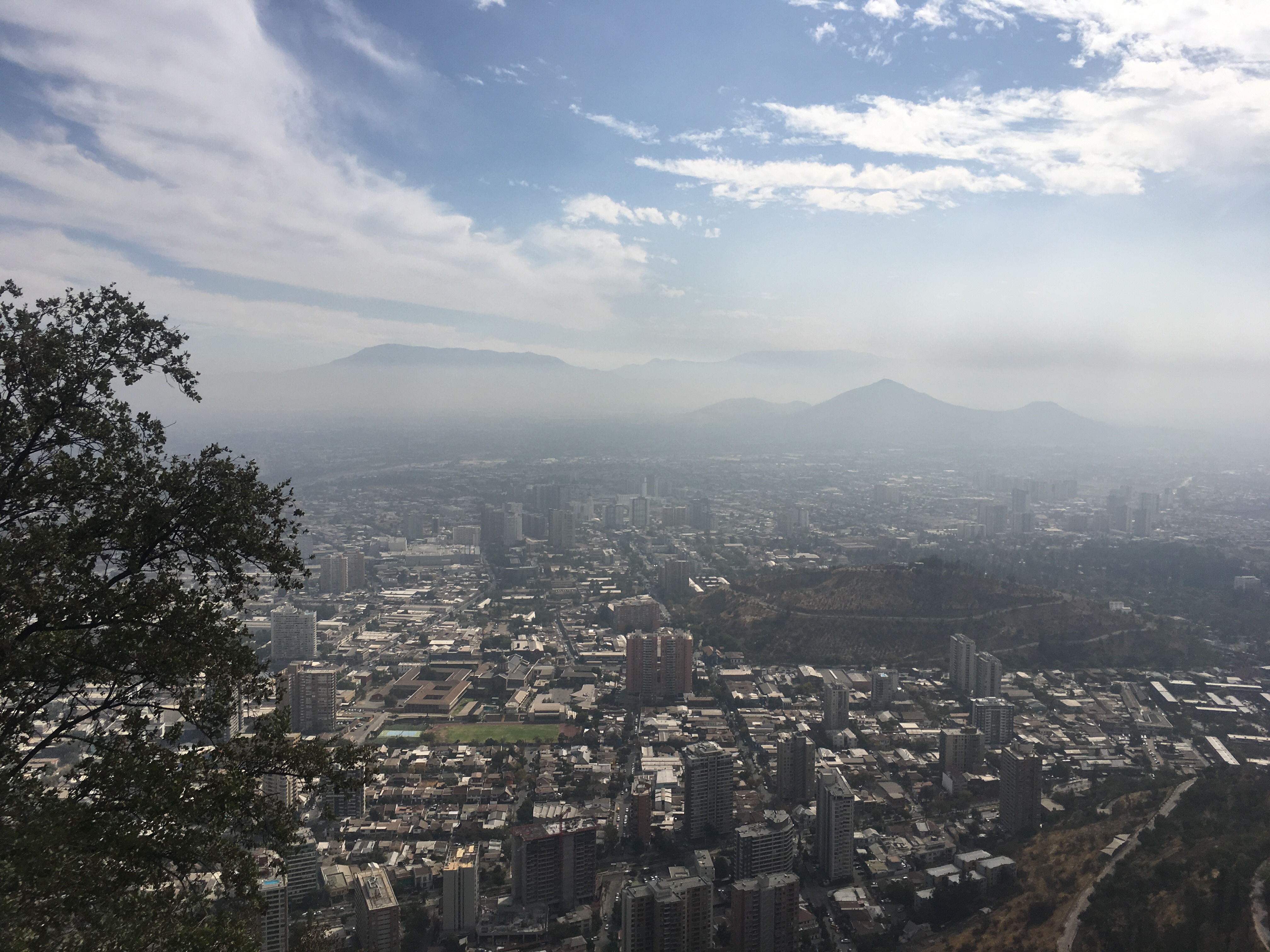
On leaving the gondola we decided to head back. Now we discovered yesterday (a little too late) that Uber is illegal in Chile, so we attempted to follow the law by using the approved Cabify app. This proved to be a dead loss, as the cab we booked cancelled arbitrarily. Back to Uber then, which proved much more successful. The driver did ask me to sit in the front, to make it less obvious that he was breaking the law. It was a long, slow journey in very heavy traffic, but we made it back to the centre of town in time for a second shopping expedition of the day, this time to buy some binoculars.
With our shopping competed we returned to the AirBnB apartment and bathed before heading out to a Peruvian restaurant, El Ají Seco. There were plenty of people with Peruvian features inside, which we took to be a good omen, and indeed it was.
The following day we awoke to clear blue skies here in Santiago. We’d decided that this was the day to visit Valparaiso, which lies on the coast sixty kilometres to the west of Santiago. We walked south on Teatinos, past impressively laid out squares and imposing government ministries to the Metro station at La Moneda. After successfully re-charging the “Bip” card (kindly provided by our AirBnB host Francisco) we hopped on the Metro for a short journey out to Pajaritos. Here we bought tickets for the bus to Valparaiso.
We couldn’t help noticing that as our bus journey continued the weather seemed to be closing in. Still, we were up in the hills, so by the time we’d descended again it was bound to be sunny. Right?! Except that it wasn’t. On arrival at Valparaiso’s central bus station we were greeted by low clouds and light rain.
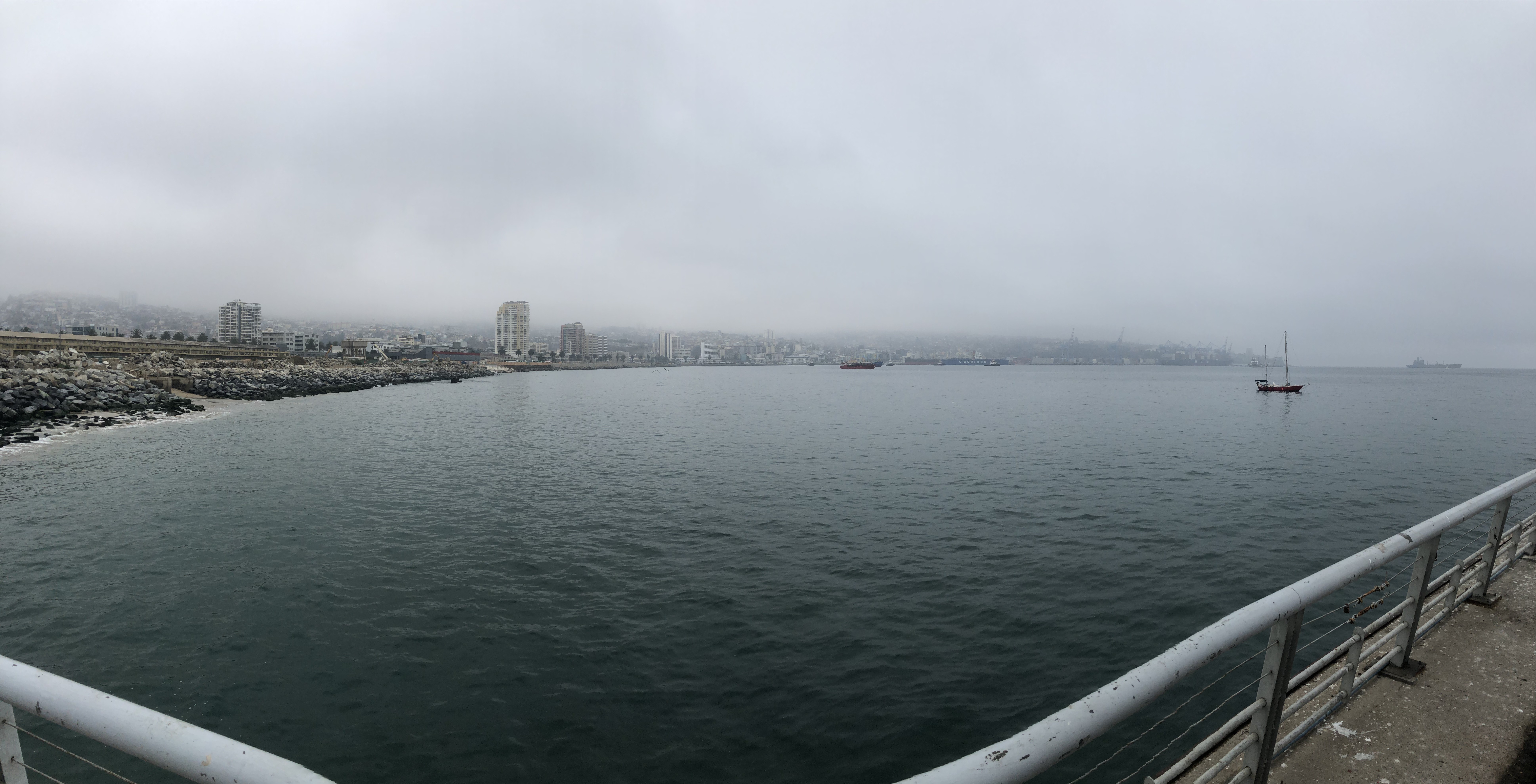
Ah well, time to have a look around, that’s why we’re travelling. So we allowed ourselves to be talked into a four hour guided tour of the city, by bus and on foot. This turned out to be a good choice, despite the weather.
Like New Zealand, Chile is part of the Pacific “Ring of Fire”, lying on the boundary between two tectonic plates (the Nazca and South American plates). In 1906 a massive four minute earthquake, measuring 8.2 on the moment magnitude scale) hit Valparaiso. The earthquake and resulting tsunami destroyed most of the town. Most of the buildings are therefore more recent, and there is no characteristic style – we were shown a huge variety of buildings ranging from elegant to brutalist.
Our tour consisted of a number of ten minute stops, giving us the chance to wander around. The weather, though, was getting progressively worse, and we were thoroughly under-dressed for the conditions! It was quite cold and wet, and we bore this stoically – as our companions on the tour noted, we are English and used to this sort of thing. One poor gentleman from Colombia had to borrow a coat from the tour guide, and was still shivering!

Undeterred, we continued, enjoying visits to Plaza Sotomayor and then a steep climb up into Cerro Alegre, one of the city’s many hills, and an area of preserved historic buildings. Here, in a brief respite from the conditions, we took lunch, before a final walking tour which included some very colourful buildings, some of which had been painted with murals by art students.
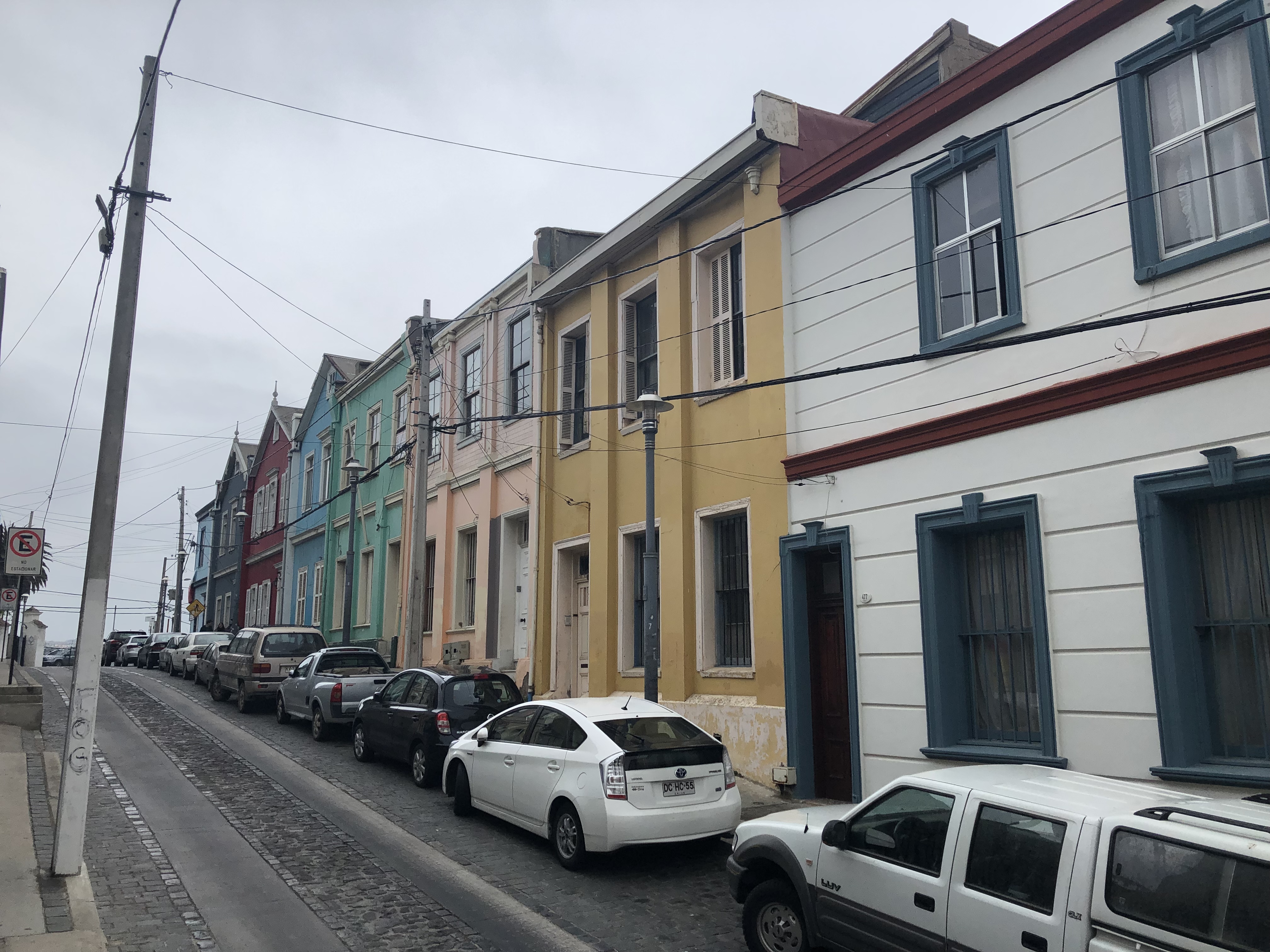
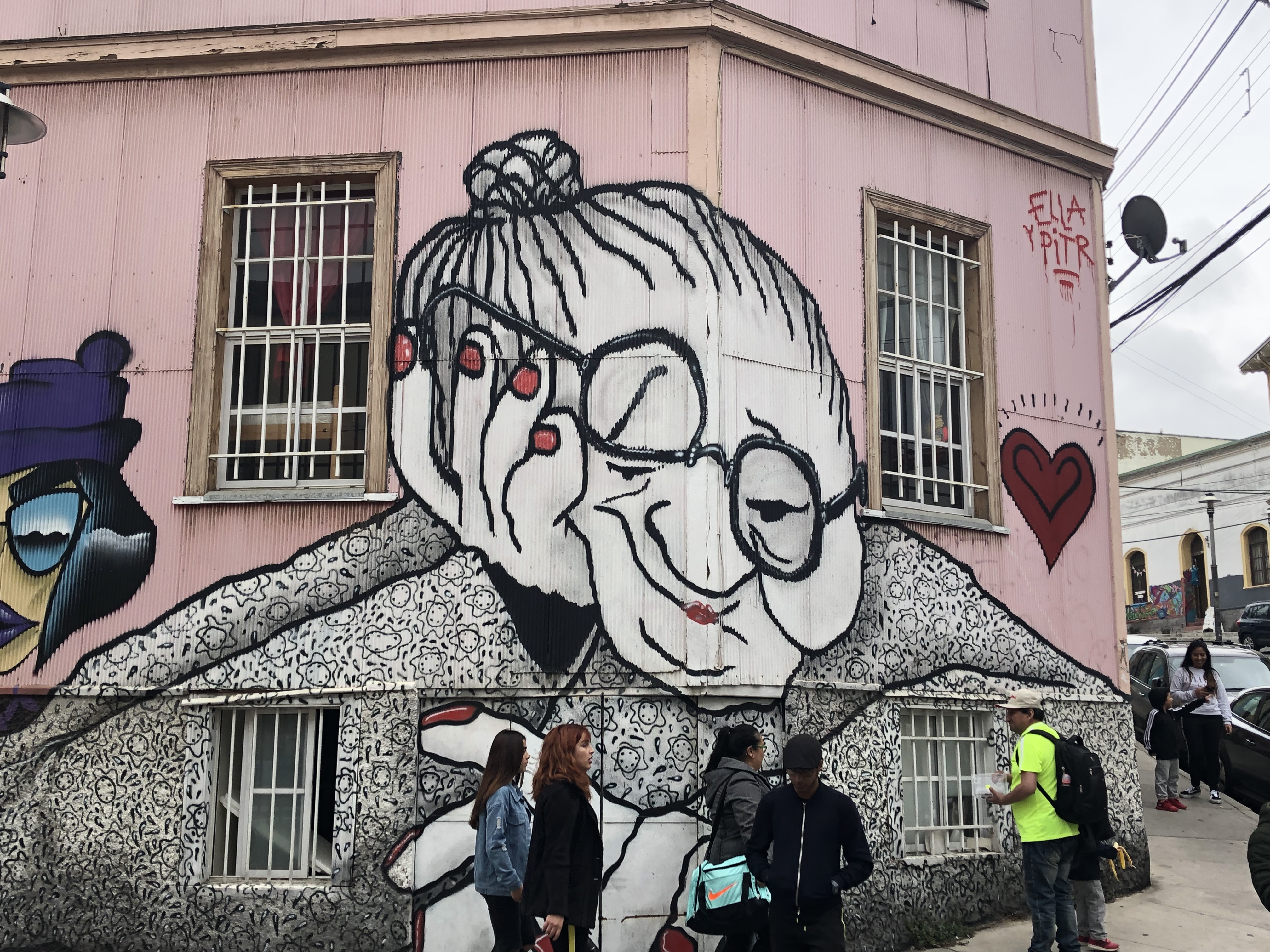
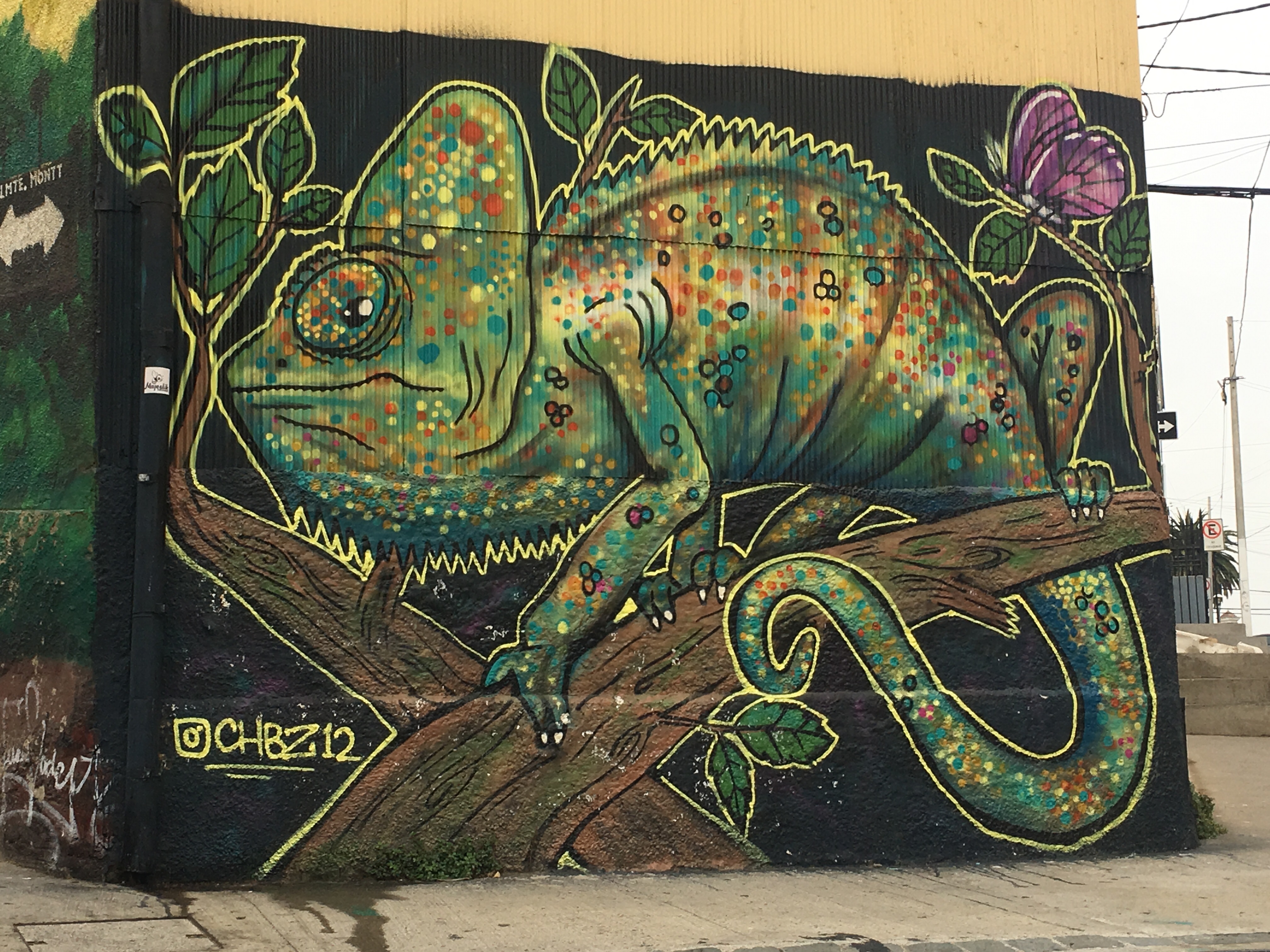
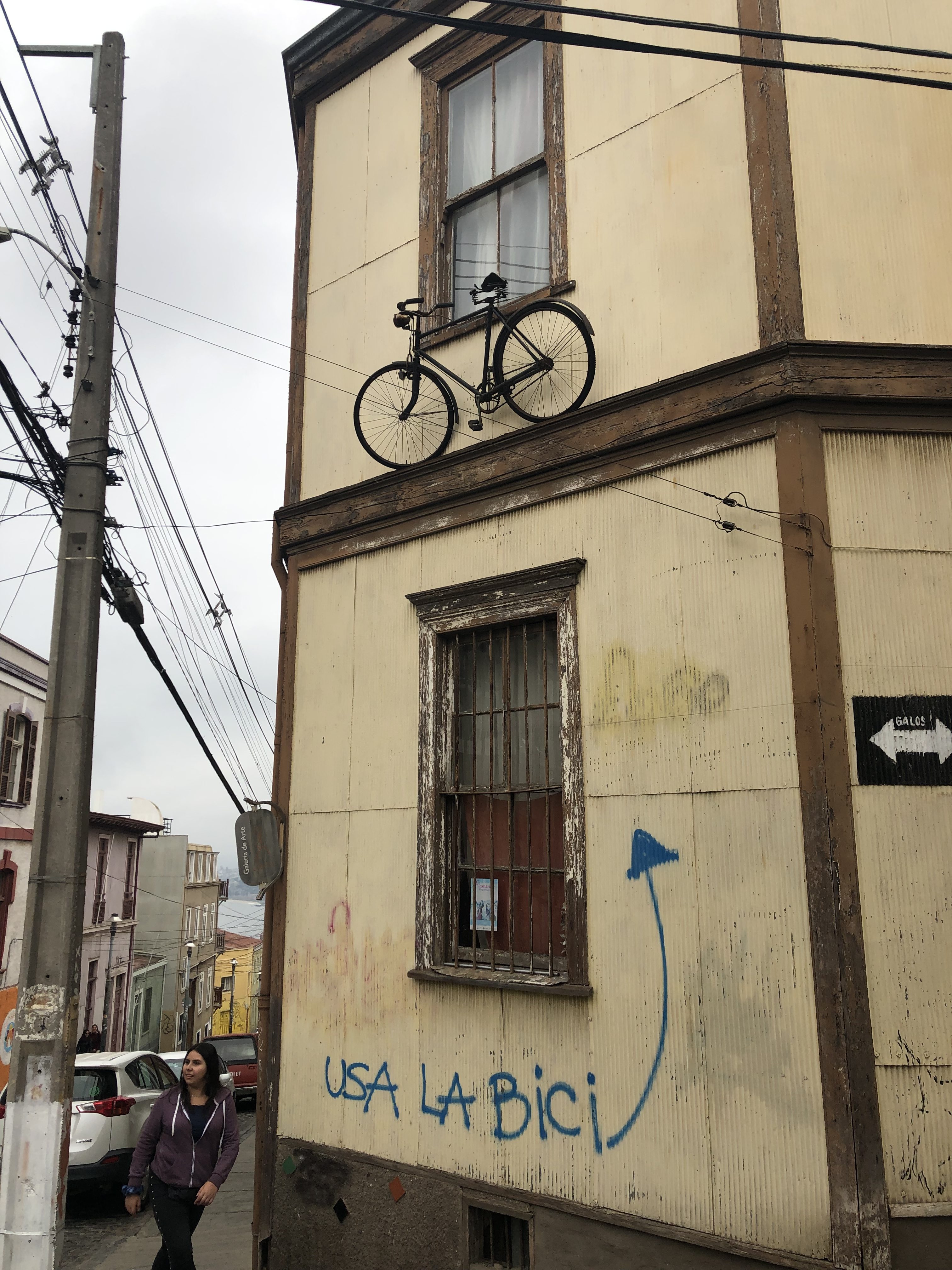
We also visited one of the houses of the poet and politician Pablo Neruda, who fell victim to the abhorrent Pinochet regime. Nearby, in a small and colourful square, are three bronze commemorative statues, their hands polished brightly by repeated contact with visitors.
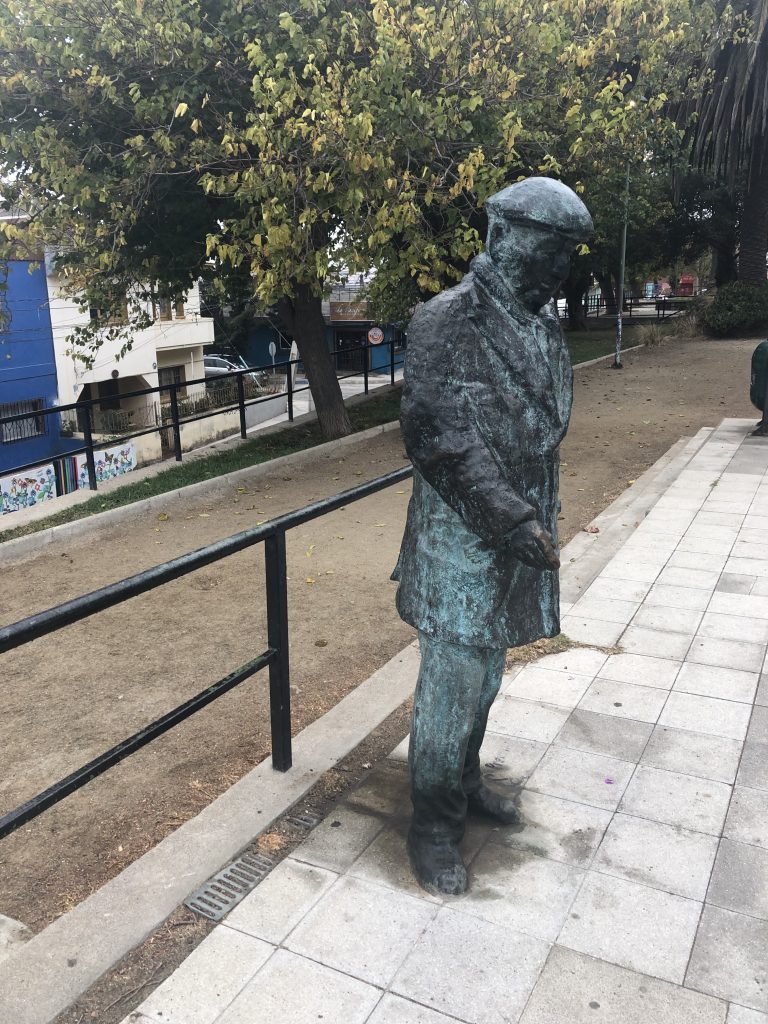
Most of the people on our tour were continuing to Viña Del Mar, but to be honest we were too cold and becoming a little weary!
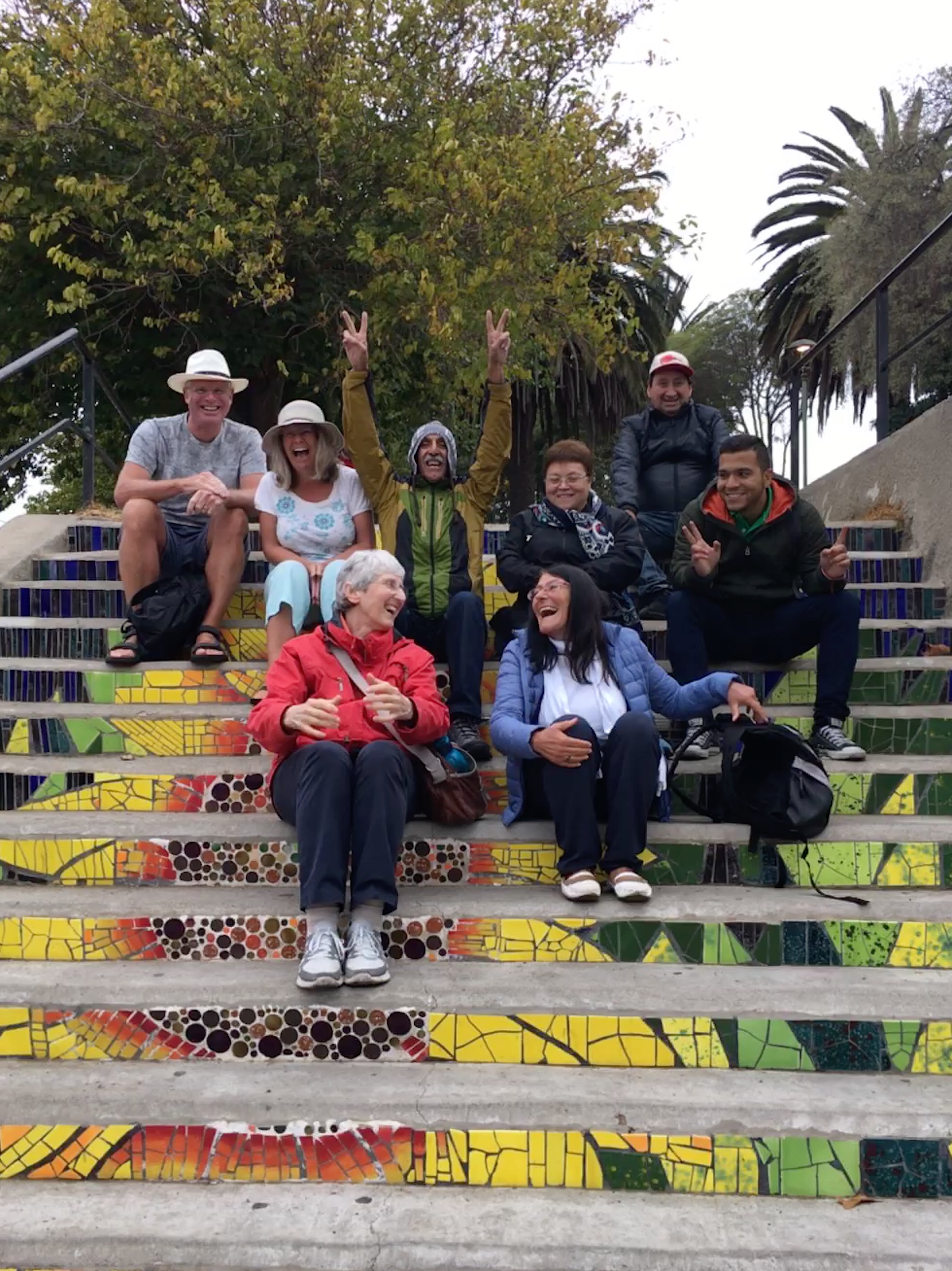
Thankfully our journey back to Santiago was an efficient one, and we were soon back in the warm comfort of our apartment. We’re happy that we made the journey, though. Valparaiso on a sunny day must be a joyous place!
Our last day in Chile was a brighter one. We had a lot of organising to do, as we will have two long-ish flights tomorrow en-route to our next stop. This did leave time to head for the Santa Lucia hill and the Lastarria Barrio. Francisco had recommended the Santa Lucia hill, mainly for the sculpture park that surrounded it. We approached in bright sunshine, which was something of a relief after yesterday. As we wandered up the base of the hill we became aware of crowd noise from the other side. This turned out to be a very lively protest against Chile’s Pinochet-era pension system!
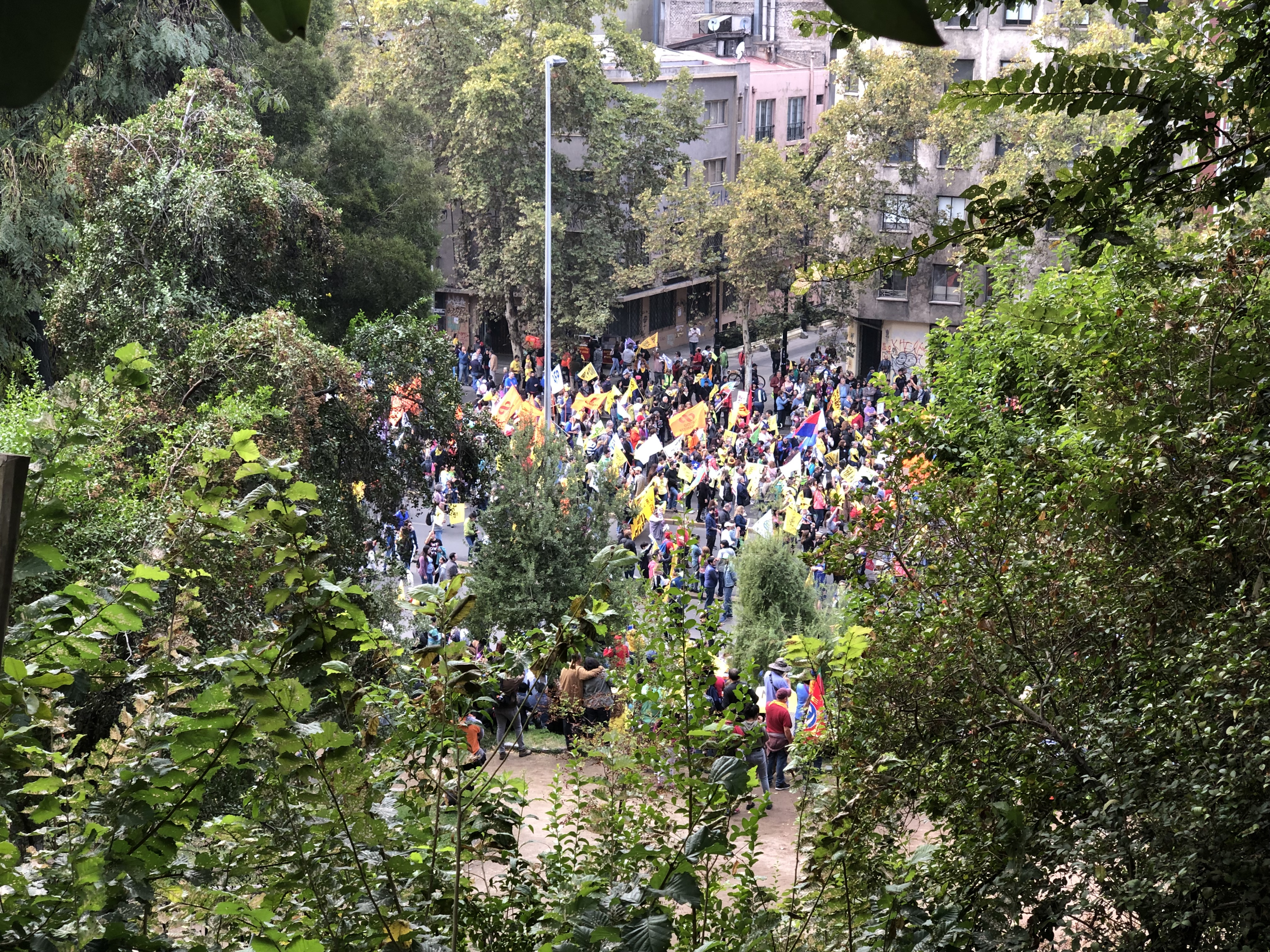
The noise accompanied us on a steep-ish climb to the top of the hill, which gave us good views over Santiago towards the coastal mountain range.
Our descent brought us down to the Lastarria Barrio, a small area of street markets and attractive buildings. This looked like a good place for lunch. We chose empanaditos (with a very spicy and quite delicious chilli sauce) and a very good bottle of Chilean chardonnay, and enjoyed a very pleasant hour reminiscing about our trip so far.
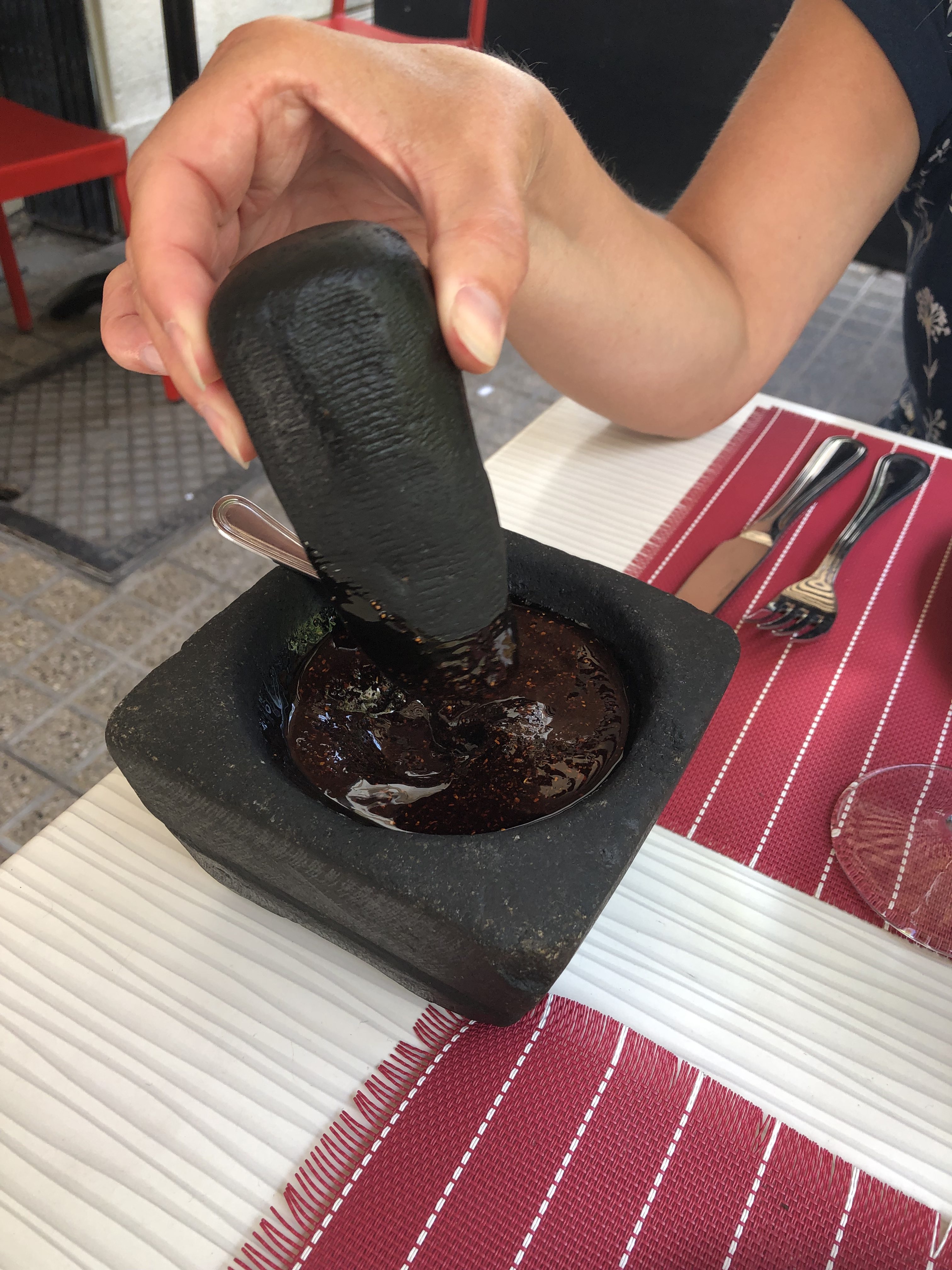
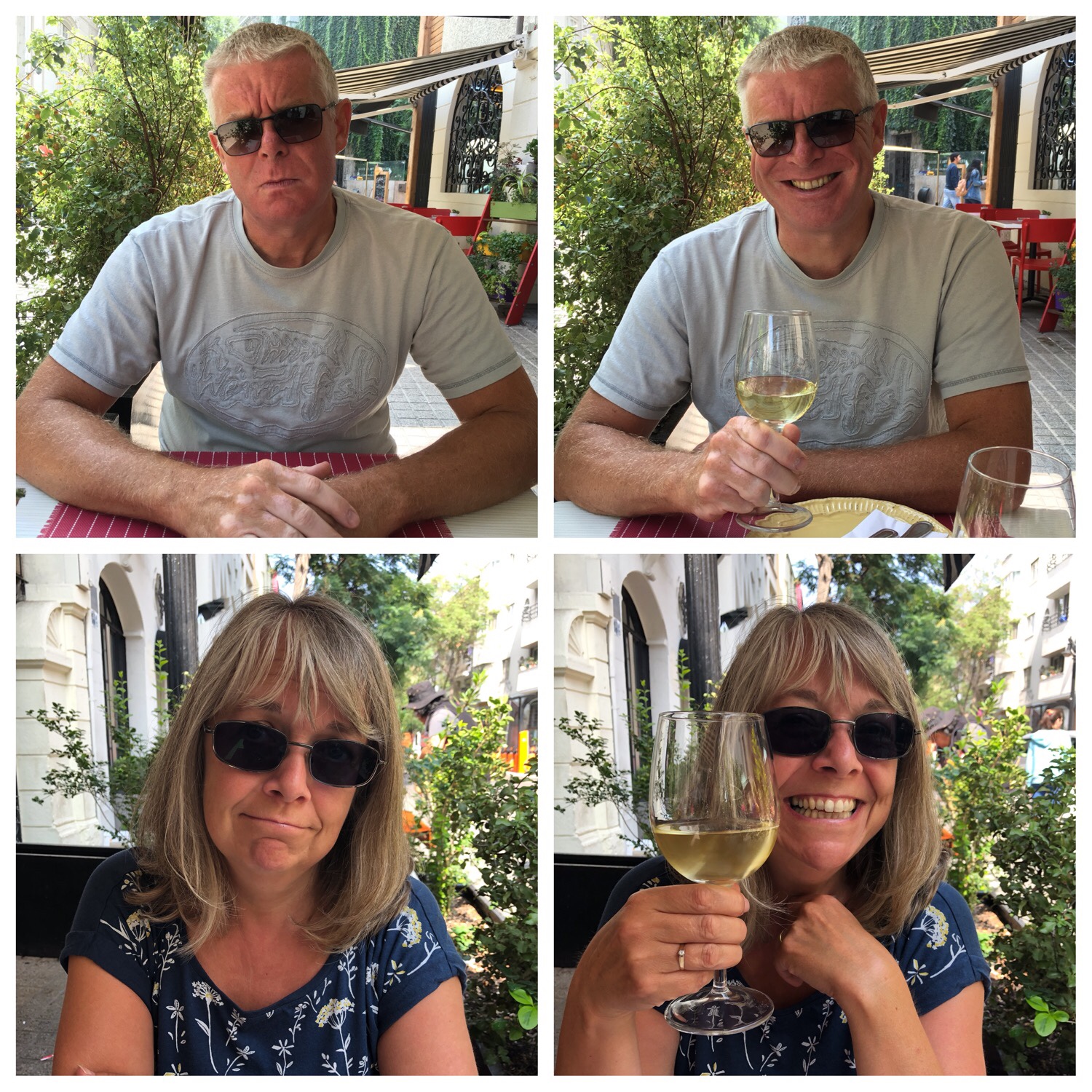
We also discussed Santiago. It’s a striking place. The public buildings have a sort of confident and muscular austerity that befits a capital city. There’s a lot of concrete too, some of it pretty ugly, but there’s plenty to please the eye. There’s a very positive feel to the city, and it has been a vibrant and interesting place to stay.
On our last evening we returned to the Lastarria Barrio, on a recommendation from Dennis and Sarah (for which much thanks!). Firstly we had a Pisco sour in a small bar, before heading to Bocanáriz, a fantastic restaurant with a great selection of wines and some intriguing tapas-style dishes. There was a great atmosphere in there and we had a really good meal. All that remained was to walk past the Plaza de Armas for one final time, back to our apartment. Tomorrow we will have an early start as we must first fly to São Paulo, then after a few hours take a second flight on to Manaus. There we will meet up with Colin for the Brazilian phase of our journey. Exciting!
